Off the Unbeaten Track Edward Adrian-Vallance's travel site
- About Edward
- Country guides
- Overland Travel
Yali men in Waniyok, Yalimo

Introduction
New Guinea, just north of Australia across the Torres Strait, is the world’s second-largest island. Its dense rainforests, the largest in the world after the Amazon , and its almost impenetrably rugged mountainous terrain ensured that throughout its history almost every tribal group remained fairly isolated even from its closest neighbours (although a certain amount of trade between groups did occur). As a result the island has around 1,000 different languages, one fifth of the world’s total.
The eastern half of the island is an independent country called Papua New Guinea. The western half is an unwilling province of Indonesia called West Papua. Papua New Guinea is by far the more developed and very few locals wear anything other than western dress these days whereas in remote parts of West Papua a few people can still be seen wearing traditional (un)dress during everyday life.
As an example of just how isolated some parts of West Papua still are, cannibalism and tribal warfare continued in parts until the 1990s and there are still unconfirmed rumours among loggers and gold prospectors of encounters with naked nomadic tribes in the depths of the Mamberamo. In 2006 a scientific expedition flew by helicopter into a valley in the Foja Mountains that was so remote it had never been accessed even by locals. Dozens of new species of animals were discovered that had evolved in isolation from humans and as a result were unafraid to walk right up to researchers.
As a tourist, however, you will be disappointed if you come to West Papua expecting to see “Stone Age” tribes. Even in Yali country , the most traditional part of the Highlands, only about 10% of people still wear the traditional penis gourds (kotekas) or women’s bark dresses. In the Korowai area in the South of West Papua the number is higher but in general western clothing has made inroads everywhere. If you can ignore that though you will have a great time: the culture is still extremely traditional, the scenery is spectacular and the locals are friendly and in some parts still very surprised to see outsiders.
In the Mamberamo area in the north of Papua that was until recently closed to tourists there are, as mentioned above, rumours about “uncontacted” tribes, although the veracity of these rumours is hotly debated. In general Mamberamo villagers all wear western dress, although they may strip it off to go hunting in the jungle.
Be warned: if you see any organisation offering “First Contact” tours it is a scam. If you spend some time in West Papua, know Indonesian and make friends with locals you may find people willing to tell you their stories of being paid by tour companies to dress up as the supposed “uncontacted” tribe. There are plenty of them around.
If you see photos where large numbers of people are all wearing traditional dress, this means they were either taken at least a decade ago or the people dressed up especially for that photo.
New Guinea has been inhabited by Melanesians for 40,000 years and its people developed agriculture at a very early stage, at least 10,000 years ago. In more recent millennia Austronesians arrived from South East Asia and settled the coastal regions of New Guinea, maintaining a certain amount of trade with nearby parts of Indonesia and with the tribes of New Guinea’s interior. New Guinea was first sighted by the Portugese in 1511 and landed on by the Spanish in 1545. Since then various parts of it have been under Spanish, French, British, German, Australian, Dutch and, today, Indonesian rule. However, in practice even the coastal inhabitants of New Guinea had no real contact with Europeans until 1855 when some Dutch missionaries arrived.
The first Dutch posts were set up in the far north and south of the island in the late 1890s and early 1900s and the capital Jayapura, then called Hollandia, was established in 1910. In the 1920s a few groups of explorers had some very brief contact with the Dani people of the Baliem Valley in the Central Highlands but the area was not properly explored until 1938 when the Baliem Valley , an area that had previously been assumed to be uninhabited, was shown to be home to 100,000 “uncontacted” Dani tribesmen. However, no missionary post was set up in the Baliem Valley until 1954 and the first missionaries reached the neighbouring Yalimo in 1961. A government post was set up at Angguruk , the largest village of the Yalimo , in 1968. Since then all the tribes of the Central Highlands have been baptised, although the new religion remains mixed somewhat with some older pre-Christian beliefs. There are still people in the Yalimo who remember seeing those first white men walking down from the mountains into their village.
After the Dutch gave up Weat Papua it quickly went over to Indonesian control after a very controversial vote in 1969, a move very unpopular with West Papuans who are ethnically and linguistically completely unrelated to Indonesians. A guerilla separatist movement, the OPM, has been operating in the interior ever since. Also since then the government has moved hundreds of thousands of migrants in from other parts of Indonesia and along with America has been busy extracting West Papua’s very rich resources (gold, silver and copper) while the people remain the poorest in Indonesia .
Until 2001 it was called Irian Jaya, although this name is very unpopular among locals who prefer West Papua. Confusingly, since 2003 West Papua has also been officially divided into two Indonesian provinces: West Papua and Papua.
The first thing to know about travel in West Papua is that everything (guides, transport, permit) can be arranged very quickly and easily upon arrival even if you don’t speak a word of Indonesian. DO NOT on any account think that it’s necessary to book one of those ridiculous adventure tours sold on the internet or by travel agencies for thousands of dollars. In a place as undeveloped and with as few facilities as West Papua, tour companies really can’t offer you anything that you can’t just arrange yourself the same day you arrive.
One very important thing to note is that when applying for your visa, some Indonesian embassies such as the one in London will tell you that it’s impossible to go to West Papua as a tourist. I have no idea where they get this rubbish from but just DO NOT write on your visa application form that you plan to visit West Papua. No one will stop you anywhere and on arrival in West Papua the police will happily issue you your surat jalan (travel permit – see below) which is all that you need to travel freely in West Papua. If, however, you write on your Indonesian visa application form that you plan to visit West Papua, some embassies may put a stamp on your visa saying “Not valid for travel to West Papua.”
The majority of tourists will fly into Sentani , the town where the airport is next to the capital, Jayapura. It is also possible to arrive at Timika and Merauke. Airlines such as Garuda, Lion Air and Merpati all fly to West Papua daily and Pelni has a few ships running here from other parts of Indonesia too.
Once you arrive in Sentani you should go to the nearest police station and pick up your surat jalan (travel permit for the interior of West Papua). It’s just a formality and requires just a few passport photos and a fee (US$5-US$20 depending on your haggling skills).
If you want to do a trek in the Central Highlands such as from the Baliem Valley to the Yalimo and maybe even on to Mek territory you will need to fly from Sentani to a town called Wamena in the Baliem Valley , the largest town in the interior. Only one road goes from the North to the Highlands. It leads from Nabire in the North (accessible by flight or 36-hour ferry from Jayapura) to Enarotali in the Western Highlands (unconnected to Wamena by road). This road is often unpassable. Shop keepers in Nabire or Enarotali should be able to tell you if anyone is planning to drive it soon.
The airline that flies to Wamena is called Trigana and has several flights every day. I never had problems just turning up and getting a seat on the same day but perhaps if you are flying around holiday time you should leave a day or two spare on either side. It costs about US$100 each way.
Once in Wamena lots of English-speaking guides will approach you. Some are quite dodgy so make sure you get one recommended by your hotel in Wamena. Many try to get you to pay for a guide plus a porter plus a cook but of course all that is really not necessary. Your guide should be able to cook for you and carry your bag. The total cost of a trek organised upon arrival in Wamena should be US$60 a day including food for you and your guide. Insist on paying him his daily fee and paying for food (fruit, veg, potatoes, rice, noodles) and accommodation yourself in villages during your trip. Don’t agree to scams such as giving him the money and letting him take care of everything, paying him in advance or paying him extra to take you to an extra-remote place.
If you speak Indonesian you can go out to the villages by public transport and hire a local to be your porter. These non-English speaking locals will be far more honest than the Wamena guides mentioned above. This way maximum total costs per day during your trek should be US$40 (see Baliem Valley page for breakdown).
If you want to visit the famous tree house-dwelling Korowai tribe in the south of West Papua, an entire 2-week trip starting and ending in Sentani with an English-speaking guide should cost US$1500 if flying to Dekai then traveling by local boats to the start point of your trek. Again, this could be slightly cheaper if you speak Indonesian and do not need a guide from Sentani. If that is so, fly to Dekai yourself and catch local boats to Mabul or Yaniruma, good starting points for Korowai treks, and find a local to guide you from there. It is also possible to trek to the Korowai from the Baliem Valley in about a month.
The Korowai area is the most traditional in West Papua. It’s also extremely hard to get around in and requires time for waiting for boats unless you want to charter your own which is almost prohibitively expensive. Indonesian language or an English-speaking guide are essential. Many Korowai still wear traditional (un)dress, live in tree houses, are semi-nomadic, still unchristianised and don’t speak Indonesian. They are not, however “Stone Age”, “Cannibals” or “Uncontacted” as some tour agencies make them out to be.
The border with Papua New Guinea also has some remote groups who wear traditional dress but getting here is extremely hard. The part of the south around Agats (accessible by river from the Korowai area via the town of Senggo or by plane from Timika) is famous for the traditional art of the Asmat people although they now dress in Western clothing. The North coast and Bird’s Head Peninsula have great diving, bird watching and trekking.
- Lani country
- Mek country
- The Baliem Valley
- The north of West Papua
- Yali country
Leave a Reply Cancel reply
Your email address will not be published.
Travel Papua
Explore the unspoilt regions of papua, indonesia.
- Tours in Papua
Discover the Unspoilt Beauty of Papua: Customised Tours with Travel Papua

Travel Papua is located in Manokwari and we offer customised tours in Papua, Indonesia. We embrace Eco – Tourism and we show respect to nature and the needs of the people who are local to the area. We explore the unspoilt regions of Papua: Baliem Valley, Korowai Tribe, Arfak Mountains in Manokwari, Nabire, Raja Ampat and more. We learn about the indigenous cultures, the great variation of wildlife in the rain forests and we make beautiful treks in the mountains.
Get inspired from the possibilities of tours in Papua that we offer. We are happy to organise your trip. We offer free quotations based on your travel-interest and time frame.
Select Your Tour by Category
Underwater adventures, trekking tours, wildlife & nature tours, cultural tours, group tours, happy customers, top 3 tours, arfak kingdom of birds.
- Arfak, Papua
Explore Raja Ampat – Piaynemo and more
- Raja Ampat, Papua
Group Tour Baliem Valley Festival (5 – 10 Aug 2024)
- Baliem Valley, Papua
Latest News
Text for latest update.
Our Destinations
Discover the natural wonders of Papua, Indonesia – a land of adventure and excitement. Whether you’re an avid diver, trekker, beach-goer, or history buff, Papua has something for everyone. Come experience the beauty of this amazing destination for yourself!
To learn more about our destinations, tour packages and customization options, please don’t hesitate to get in touch with us .
- Yali Valley
- Baliem Valley
- Manokwari 98312, Indonesië
- ask @ travelpapua.com
- +62 821 12 64 6444
- Best travel time
- How to get there
- What to bring
- Visa and permit
- Safety and health
- Terms and condition
Website partner: Own Property Abroad
- Bali Attractions
- Flores Attractions
- Java Attractions
- Lombok & Gili Attractions
- Komodo & Lesser Sunda Islands Attractions
- Alor Archipelago Attractions
- Solor Archipelago Attractions
- Kalimantan (Borneo) Attractions
- Maluku Islands Attractions
- Sumatra Attractions
- Sumbawa Attractions
- Sumba Attractions
- Sulawesi Attractions
- West Papua Attractions
- West Timor Attractions
- Need to Know
- Travel Insurance
- Language Guide
- Facts About Indonesia
- Inspiration
- Tips & Hints
- Indonesia Map
West Papua Travel Guide
West Papua marks the eastern extremity of the Indonesian Archipelago. As the western half of Papua, the world’s second biggest island, it’s a sizable chunk of land with only a relatively small population of less than 880,000. It’s a land of contrasts – an exceptionally beautiful province boasting vast tracts of impenetrable jungle, cool grassy meadows framed by snow-capped mountain peaks, powerful rivers spilling into massive lowland deltas, coastal mangrove forests interspersed with white sandy palm fringed beaches and hundreds of offshore islands including the famous karst peaks of Raja Ampat . And within this montage of landscapes, an amazing array of endemic and exotic flora and fauna such as the Bird-of-Paradise, cassowary, tree kangaroos and the cuscus, a woolly tree-dwelling marsupial.
» read more
Few places in the world boast such a rich and fascinating tribal culture as West Papua. More than 250 tribal sub-groups have been identified, each having their own language, traditions and customs. The coastal tribes were visited by Sriwijava traders from as early as the 7th century. By the 16th century, European traders were on the scene in search of spices and bestowing names such as Bougainville, Cape d’Urville and the Torres Straits.
Contact with the inland tribes came much later after the Dutch claimed the entire island of Papua in 1828. Various administrators, traders and explorers made sporadic forays into the interior and they were quickly followed by missionaries and settlers. During WWII the Japanese occupied the north for two years until Allied forces drove them out in 1944. Subsequently, the United States established over twenty bases in the region and in excess of half a million troops moved through the area. It was in Yos Sudarso Bay (then called Humboldt Bay) below the provincial capital of Jayapura that General MacArthur assembled his fleet for the invasion of the Philippines in 1945.
Despite the gradual push inland, some tribes remained completely isolated and unknown until as recently as 1970 when the tree-house dwelling Korowai tribe was discovered in the south-east. As intriguing as it is to imagine more undiscovered tribes living deep in the jungles of Papua this is not the case, despite some less than scrupulous tour companies promoting “First Contact” expeditions. It is true though, that there are still tribes living without any significant or regular contact with the modern world.
West Papua has been mired in bitter dispute ever since Indonesia won independence in 1945 and claimed all of the territory of the former Dutch East Indies. Arguing that the Papuan’s were ethnically different and vowing to maintain control over the province until the locals were capable of self-determination, the Dutch clung stubbornly to their Papua holdings. By 1961 the Indonesian’s forced the issue by invading the territory. The UN quickly stepped in and by September 1962, convinced the Dutch to relinquish the territory to a temporary United Nations administration, which would in turn transfer to Indonesia on the proviso that a plebiscite, the so-called “Act of Free Choice” would be held before 1969 to enable the local population to determine their own future.
The subsequent plebiscite has been widely criticised as anything but an “Act of Free Choice.” Voting was restricted to 1,025 musyawarah , a consensus of elders carefully selected by the Indonesian military and coerced into unanimously voting for integration with Indonesia. Pro-independence activists immediately began campaigning through diplomatic and peaceful protest for a re-vote on a one man, one vote basis. Their calls fell on deaf ears. By 1976 the Free Papua Movement (OPM) stepped up their campaign by sabotaging the massive Freeport gold and copper mine in the central highlands. It was the beginning of a guerrilla warfare campaign that has continued ever since, particularly around the Freeport Mine region. Allegations of swift and violent retribution by the Indonesian security forces against OPM supporters, and anyone viewed as sympathetic to the separatist movement, have been widespread.
Throughout much of this period, the Indonesian government actively promoted the migration of hundreds of thousands of Indonesians from other parts of the archipelago, particularly overpopulated Java. It’s a strategy critics have decried as an attempt to “Indonesianise” the province. And whilst the indigenous culture remains distinctly and proudly Melanesian, the Indonesian influence is evident. Bahasa Indonesia is now widely spoken across the province, the distinctive Indonesian architecture is evident everywhere, traditional staples such as taro and yam have been substituted with rice, and whilst the population remains predominantly Christian, Islam is becoming more prevalent.
Perhaps this is why the Indonesian government has relaxed its stance against foreign tourists in recent years. It is now quite easy for intrepid travellers to venture to most parts of the province. For adventure seekers, the region is oozing with possibilities; trekking, mountain climbing, dirt biking, village homestays, river journeys or simply losing oneself in tropical splendour for a week or two. Those with deep enough pockets can sail the Raja Ampat in liveaboard luxury, dive some of the world’s best coral reefs or make flying visits to highlands tribes. So whilst West Papua may be well off the beaten track it’s definitely beeping louder on the tourist radar.
» read less
Attractions
Discover the best of West Papua
Accommodation
Understand, find and book here
Map & Orientation
Know your way around
Travel permit requirements
Getting In & Out
Entry & exit points and transport options
Getting Around
By air, land or sea
—– WEST PAPUA QUICK LINKS —–
West papua main page.
Air Sea Land
Travel Permit Air Road Boat
Footer Menu
- Privacy Policy
- Terms and Conditions
- Contributor Guidelines
Our Philosophy
- Jawaharlal Nehru (Indian Prime Minister 1947-64)
E-mail: [email protected]
Website: http://www.roamindonesia.com
Indonesia , Worldtrip
2 Weeks Itinerary for West Papua, Indonesia
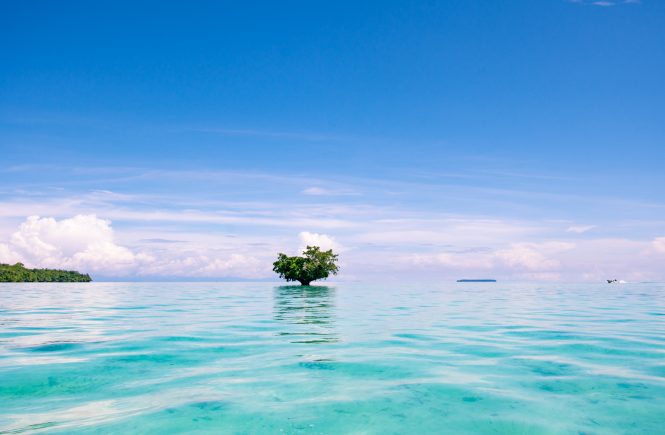
We never expected we would stay in West Papua for so long, but its wonderful nature and unique culture really got us. Not many people travel to West Papua and the development in the area goes slowly which makes it a place you will not find anywhere else in the world, so pristine and beautiful. There is not much information available online or in print and the flight connections are scarce. So we summarised our favourite 2 -3 weeks West Papua itinerary here. Don’t miss out any highlights and save time an resources flying efficiently.
2 Weeks West Papua Itinerary
Jakarta/bali —> sorong (raja ampat) —> jayapura (baliem valley) —> nabire (whale sharks) —> biak (beaches and diving) —> jakarta/bali.
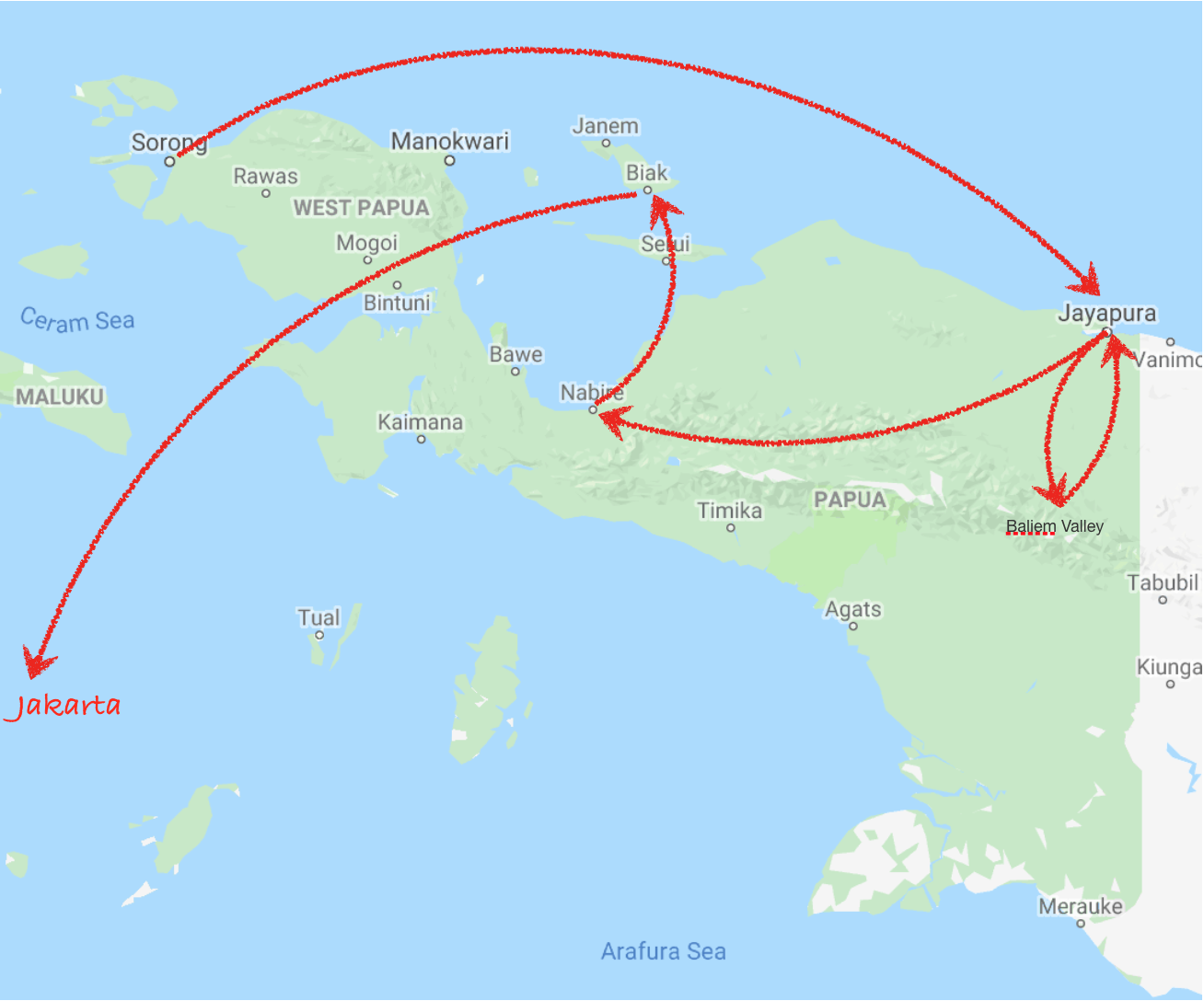
Start out from Bali or Jakarta and fly to Papua’s most famous dive spot Raja Ampat. There is no need to stay in Sorong try to get to your resort or homestay on the day of arrival and enjoy a magical underwater world. Explore the jungle and observe the birds of paradise’s mating dance. You should at least stay 4 days there is really lots to do and see in Raja Ampat.
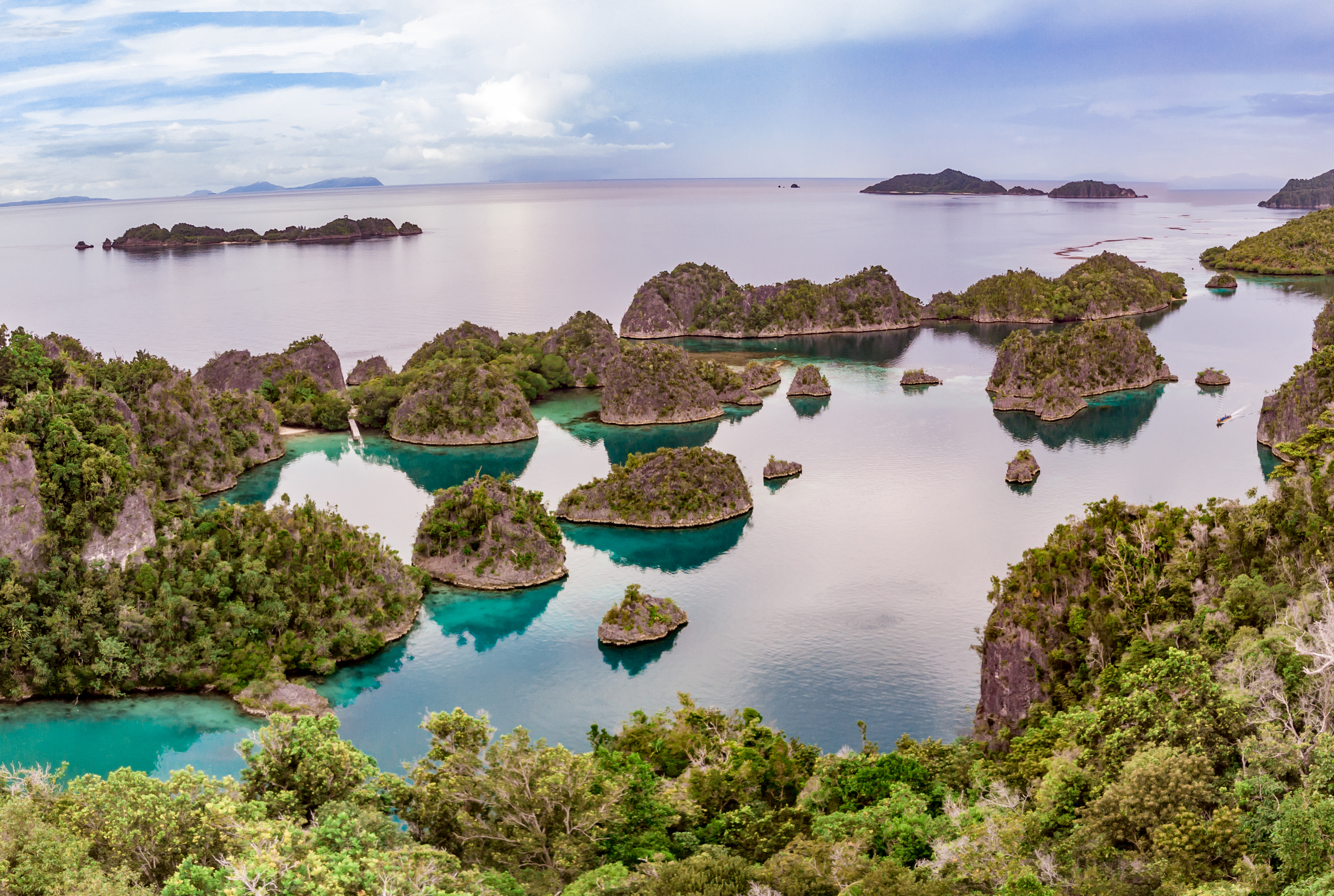
From Sorong you can fly to the capital of West Papua Jayapura to get your connection flight to Wamena (Baliem Valley) for an unforgettable hiking trip in the highlands. Experience the culture of the Dani tribe and they in local villages. This will take you about 4 days, but you can also spend more time walking to further villages. The longer you walk the less civilisation.
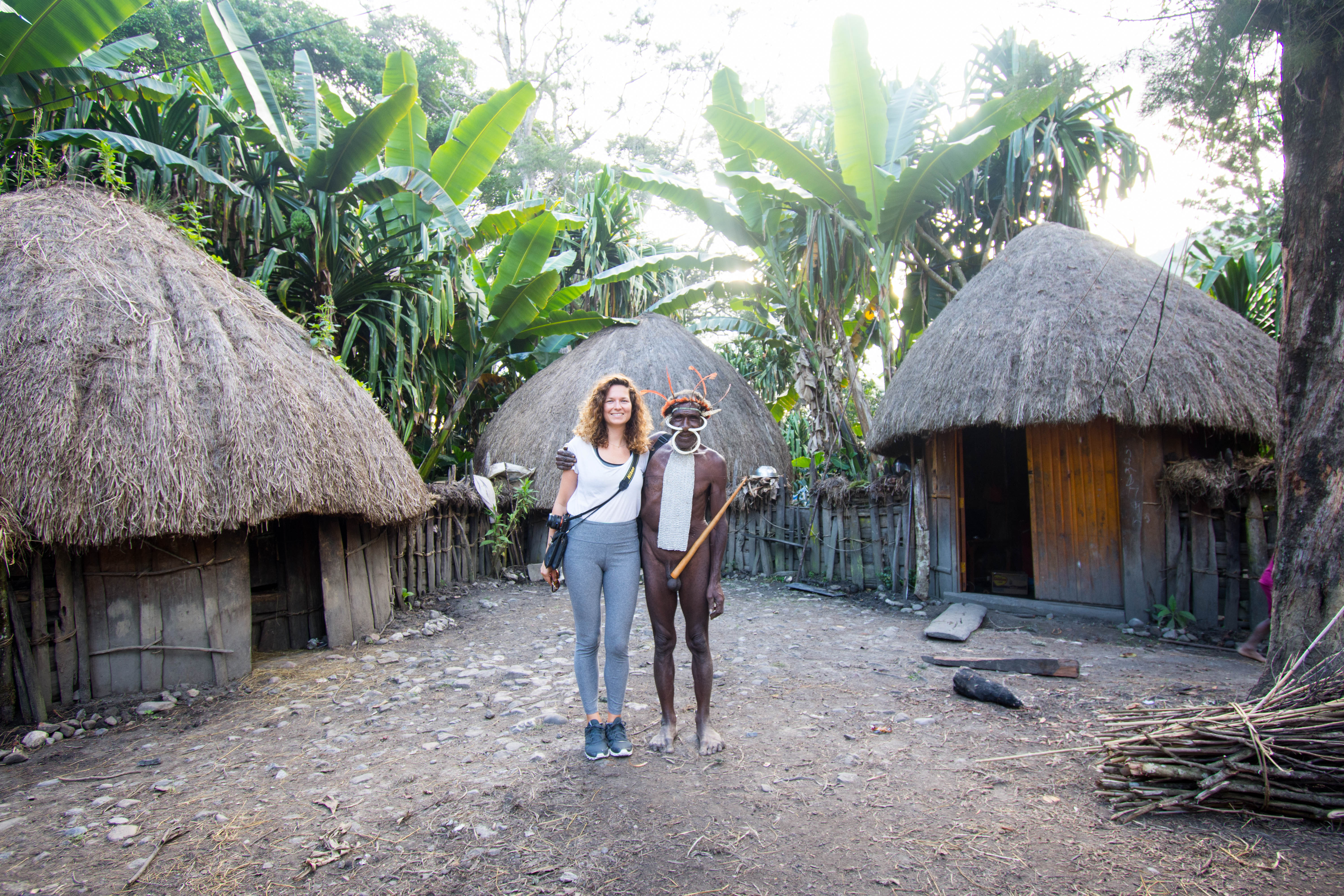
After all the hiking its time for swimming with the gents giants in Nabire . There are only a few places in the world where you can get so close to whale sharks. Don’t miss that opportunity. This will take 1-2 days depending on your arrival.

Spend the last 4 days at the pristine Padaido Atoll in Biak . Unwind and relax on untouched Pulau Wundi island. After you are rested go diving and maybe experience your first cave dive at Wundi Cave.
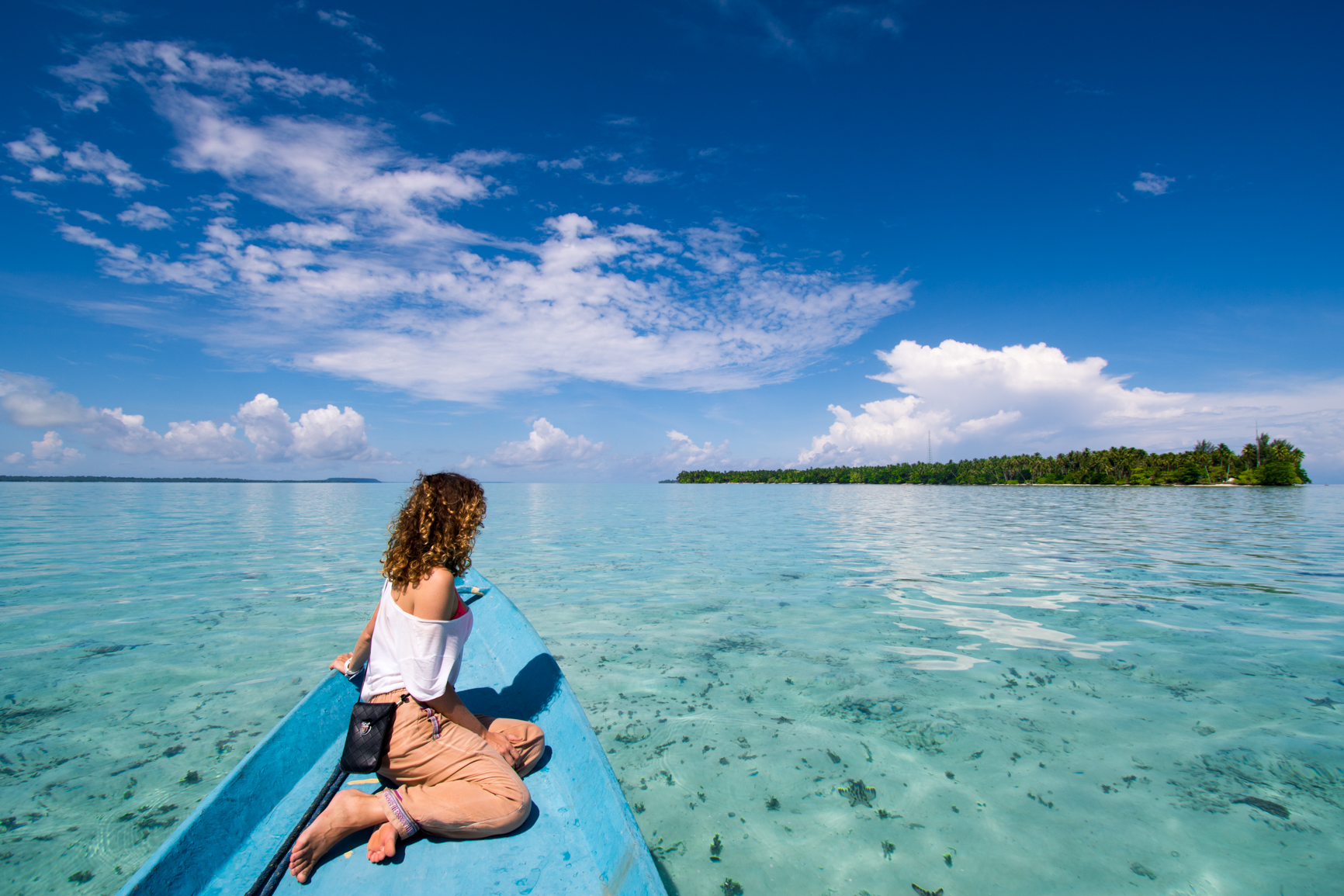
From Biak you can head back to Jakarta via Makassar.
You can also do this trip in reverse order. Just be careful there is no flight from Sorong to Nabire, only from Jayapura, Biak or Ambon. For info about every destination please read our other guides for Biak , Baliem Valley and Nabire . You can do all mentioned destinations in 2 weeks, but it would be better to have 3 weeks to full enjoy astonishing West Papua.
3 Weeks West Papua + Banda Islands Itinerary
Jakarta/bali —> ambon (detour to banda islands) —> nabire (whale sharks) —> jayapura (baliem valley) —> sorong (raja ampat) —> jakarta/bali.
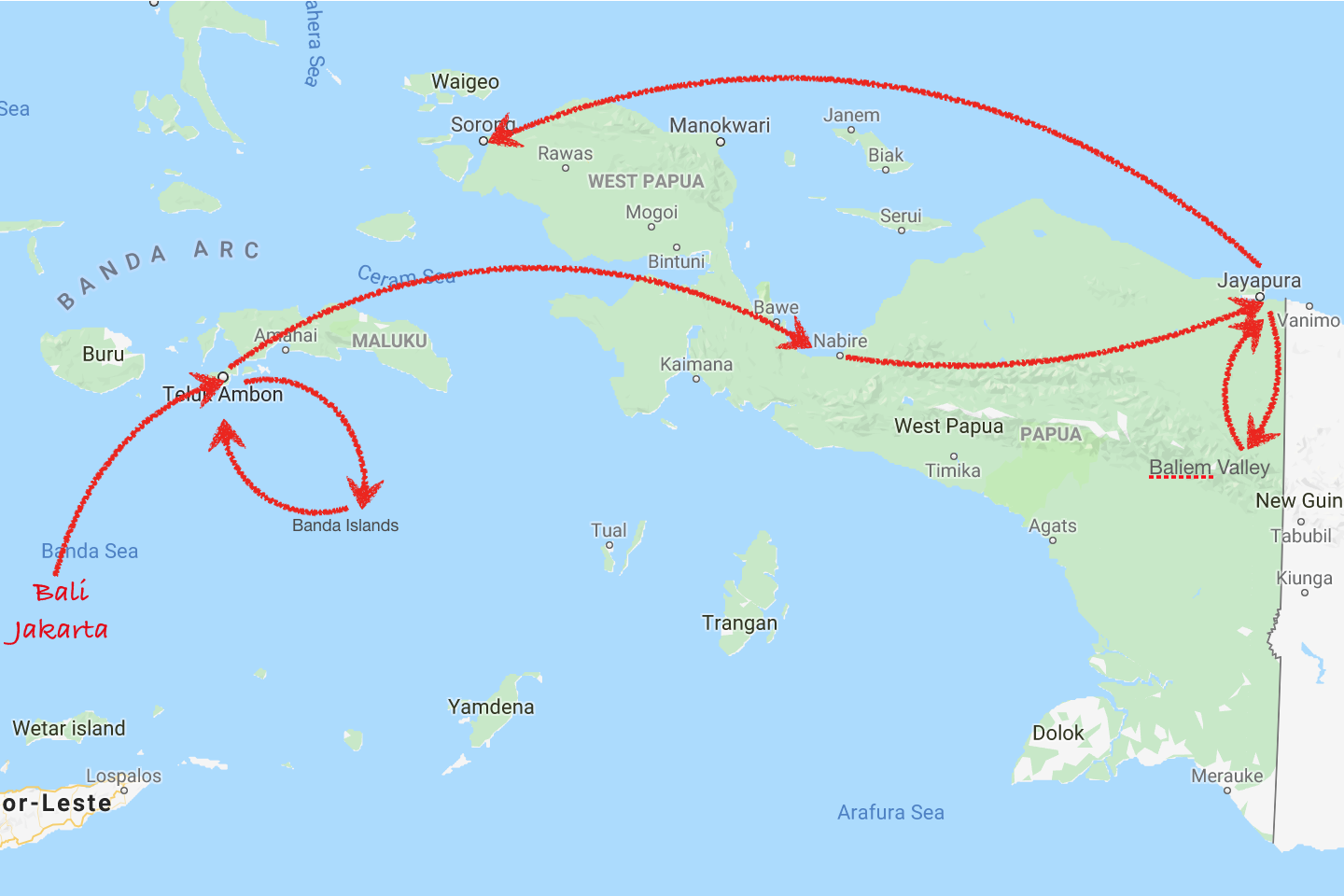
Ambon also offers connection flights to Nabire. So you could first go to the Banda Islands from Ambon for superb diving and wonderful beaches and then continue your journey to West Papua. Your first step would be Nabire to swim with the whale sharks. Afterwards you can fly to Jayapura your getaway to Baliem Valley . From there it is very easy to get to Sorong to explore Raja Ampat.
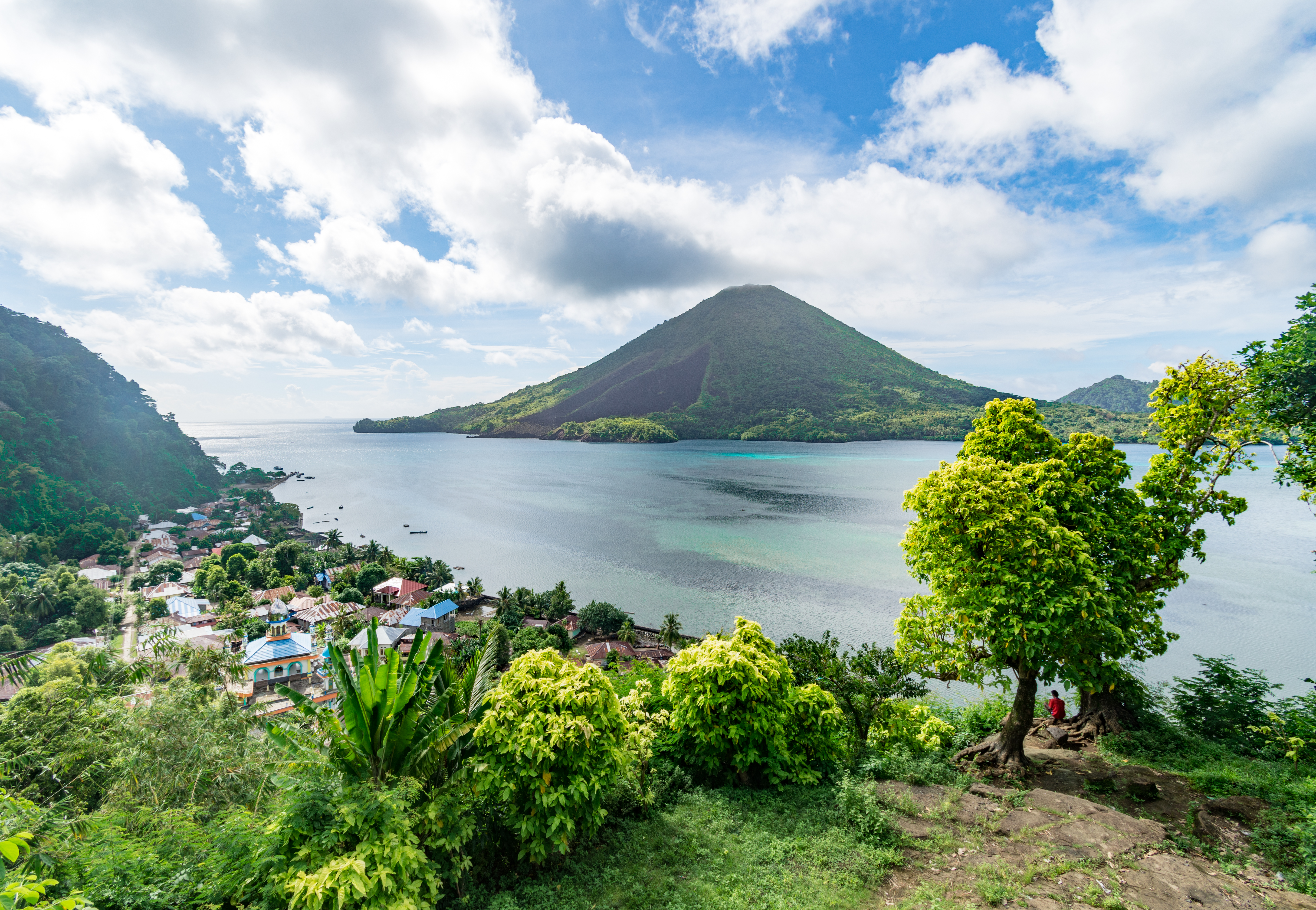
From Sorong there are regular flight to Jakarta and Bali via Makassar.
You may also like
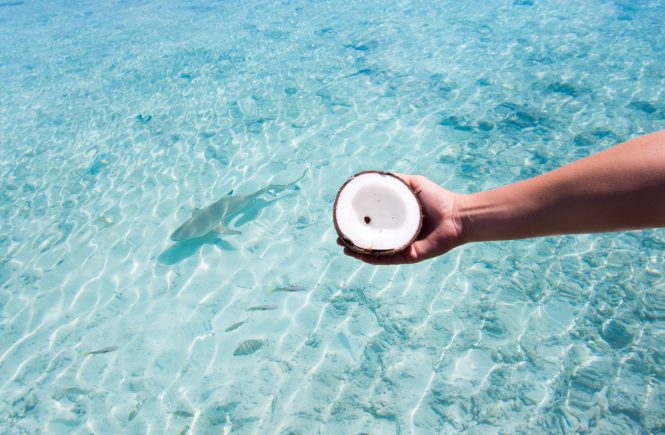
Vegan Food Guide For Your Dream Holiday in Tahiti, French Polynesia
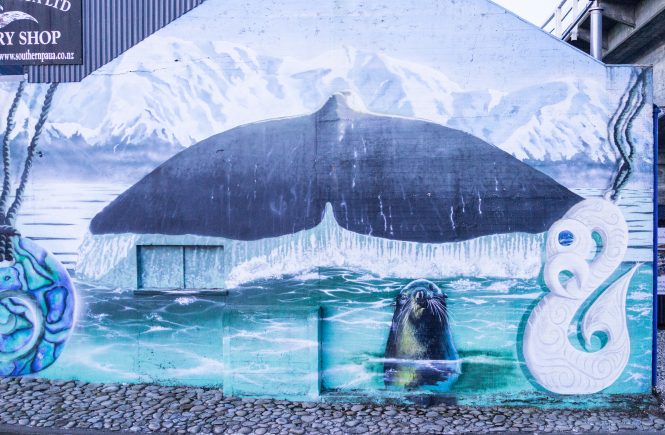
Whale Watching, Dolphin Encounters and Fur Seals in Kaikoura, New Zealand
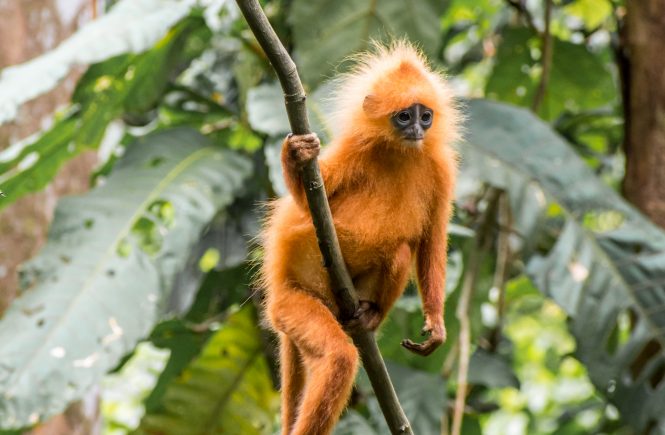
What to do at Danum Valley?
Hello! Where did you stay in Baik? I have heard of Biak Diving with Erik Farwas but cant seem to get a hold of him.
First of all thanks for sharing your story and reading our article. I am totally with you on just wanting less things for your daily care. This was also my motivation as I looked into the topic.
What I noticed during our world trip is that my hair strongly reacts to the weather conditions. If we are in dry climate I almost don’t need to wash my hair at all, but after 4 to 5 days I just have to comb it and therefore I need to wash it or make it wet. Never comb your curlies if they are dry that will make you look like a lion and also make them break. I also need to add more argan oil to my hair to keep it soft avoid breakage
In humid climate I wash more often also because we are in the ocean almost every day. For me cold or hot water doesn’t matter but I need to massage my head regularly to wash off dead skin cells.
So answer your questions it depends on the climate but water only should work for you but I guess India is quite humid so I would recommend washing every 3 day. Just try it out and let me know how it goes
All the best on your no poo journey from Mexico,
Leave a Reply Cancel reply
Your email address will not be published. Required fields are marked *
Your ultimate guide to Indonesia's Raja Ampat

Sep 26, 2022 • 8 min read

Here's what you need to know to plan the perfect trip to Raja Ampat, Indonesia's biodiversity hot spot © zaferkizilkaya / Shutterstock
The 1500 islands, cays and shoals that make up Raja Ampat lie on prime real estate at the heart of the Coral Triangle, a biodiversity hot spot where the Pacific and Indian Oceans collide.
Likened to the “Amazon of the seas,” this tropical labyrinth holds one of the world’s highest densities of marine life with over 1000 species of fish and three-fourths of all known corals. Divers and snorkelers alike dip into the aquamarine waters here in search of wildly-patterned carpet sharks, massive manta rays and pygmy seahorses. Up above, they find bungalows perched over the ocean and palms curving toward pearly beaches devoid of any footprints.
Each of the main islands – or “Four Kings” as they’re known – hides its own wonders, including mesmerizing mushroom-shaped outcrops, placid turquoise lagoons and misty hills where flamboyantly-feathered fowl parade across the canopy in search of a mate. To visit now is to experience a virgin paradise on the verge of discovery.
Here’s everything you need to know to plan the perfect trip to Indonesia 's Raja Ampat.
Waigeo is home to the region's small capital
If sleepy Raja Ampat has any whiff of a buzz, you’ll find it on Waigeo or its satellite islands Gam, Kri and Arborek. Home to the region’s diminutive capital, Waisai, this is the most logical base from which to plan journeys further afield. Waigeo is the place where British naturalist Alfred Russel Wallace based himself in 1860 while studying the birds-of-paradise, a group of 44 lavishly attired birds only found around New Guinea and north-eastern Australia. Research in the jungles here played a pivotal role in his landmark theory of evolution through natural selection, which was published jointly with the more famous Charles Darwin. You can find Wallace’s subjects fluttering about in the hills on the island’s southern edge, as well as on neighboring Gam.
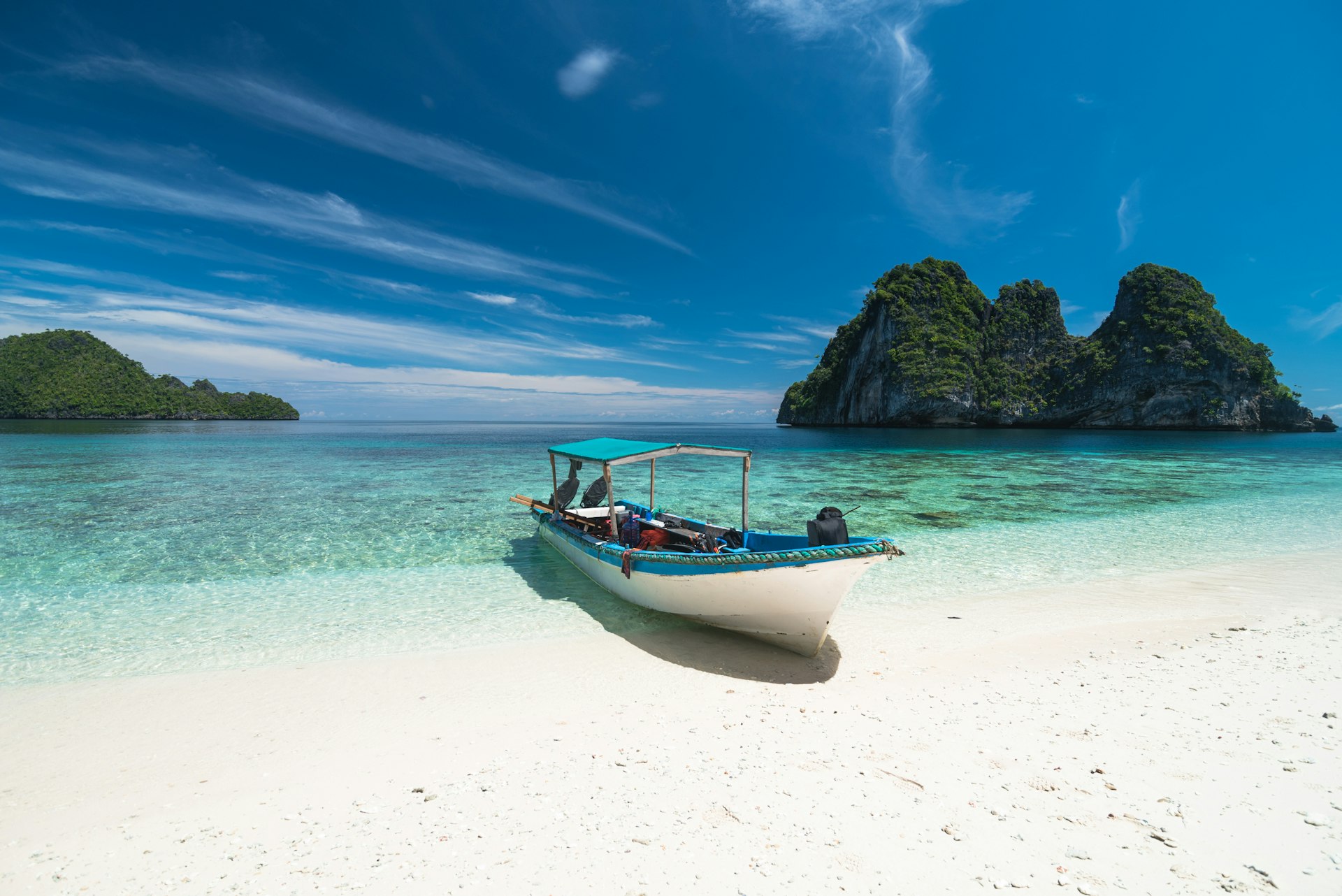
Misool is the most isolated of the "Four Kings"
Misool is the most visually arresting of the four main islands. It’s also the most isolated at the southern end of the archipelago. Its southeastern edge is a veritable fortress of towering karst formations that rise out of the sea like shards of green glass. Many of these formations hide secluded lagoons that are perfect for snorkeling or kayaking. Yet, the main draw here is scuba diving in the crystalline waters of the 300,000-acre (1220 sq km) Misool Marine Reserve , established in 2005. The island also features pearl farms, caves, prehistoric rock art and two lakes where you can swim with thousands of (harmless) golden jellyfish.
Salawati and Batanta are the least visited of the "Four Kings"
Despite being closest to mainland New Guinea, Salawati and Batanta are the least visited of the “Four Kings.” Salawati is an untouched island that lies directly across the Sele Strait from the Bird's Head Peninsula. It has little in the way of tourist attractions or infrastructure. Batanta is a long, thin island just north of it that’s home to a few tiny fishing villages. You’ll also find a handful of homestays and dive resorts along Batanta’s northern edge, as well as on the smaller satellite islands just off the coast.
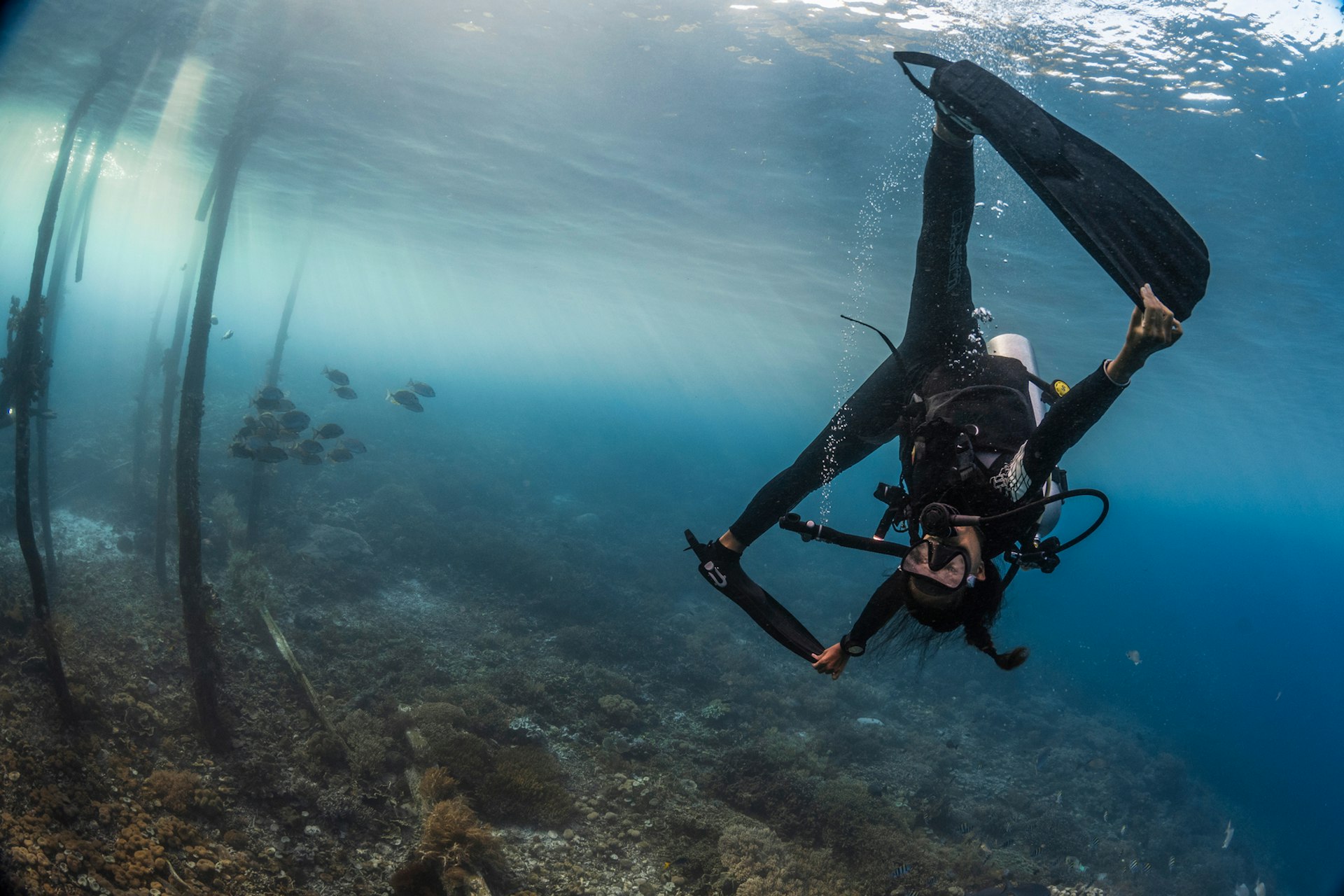
What to do in Raja Ampat
Dive (or snorkel) in misool’s protected waters.
Divers from around the world flock to Raja Ampat’s clear waters to spot soaring manta rays, giant clams, iridescent parrotfish, rare dugongs and swarming schools of yellowback fusiliers. Its unspoiled reefs are home to more than ten times the number of hard coral species found in the Caribbean. In the protected waters of the Misool Marine Reserve, you can find blue staghorns, orange sea whips and chunky brain corals, among countless others. The reserve’s disparate dive sites are best visited from a liveaboard boat or a Misool-area dive resort.
Hike to the birds-of-paradise
Walk in Wallace’s footsteps in search of the aptly named birds-of-paradise, whose elaborate courtship dances were a highlight of the BBC's original Planet Earth series. The southern coasts of Waigeo and Gam offer the best chance for sightings, with forests that harbor two species. The larger red bird-of-paradise has crimson wings, emerald cheeks, yellow shoulder tufts and wispy purple tail feathers, while the smaller Wilson's bird-of-paradise has a startling cyan cap, a red-and-black body, blue feet and tail feathers shaped like a scissor handle. Local guides run tours to see the birds along private-access trails that often begin behind their homes. Accommodation providers can arrange trips, which typically involve a pre-dawn hike up to a crude viewing blind near a popular mating area.
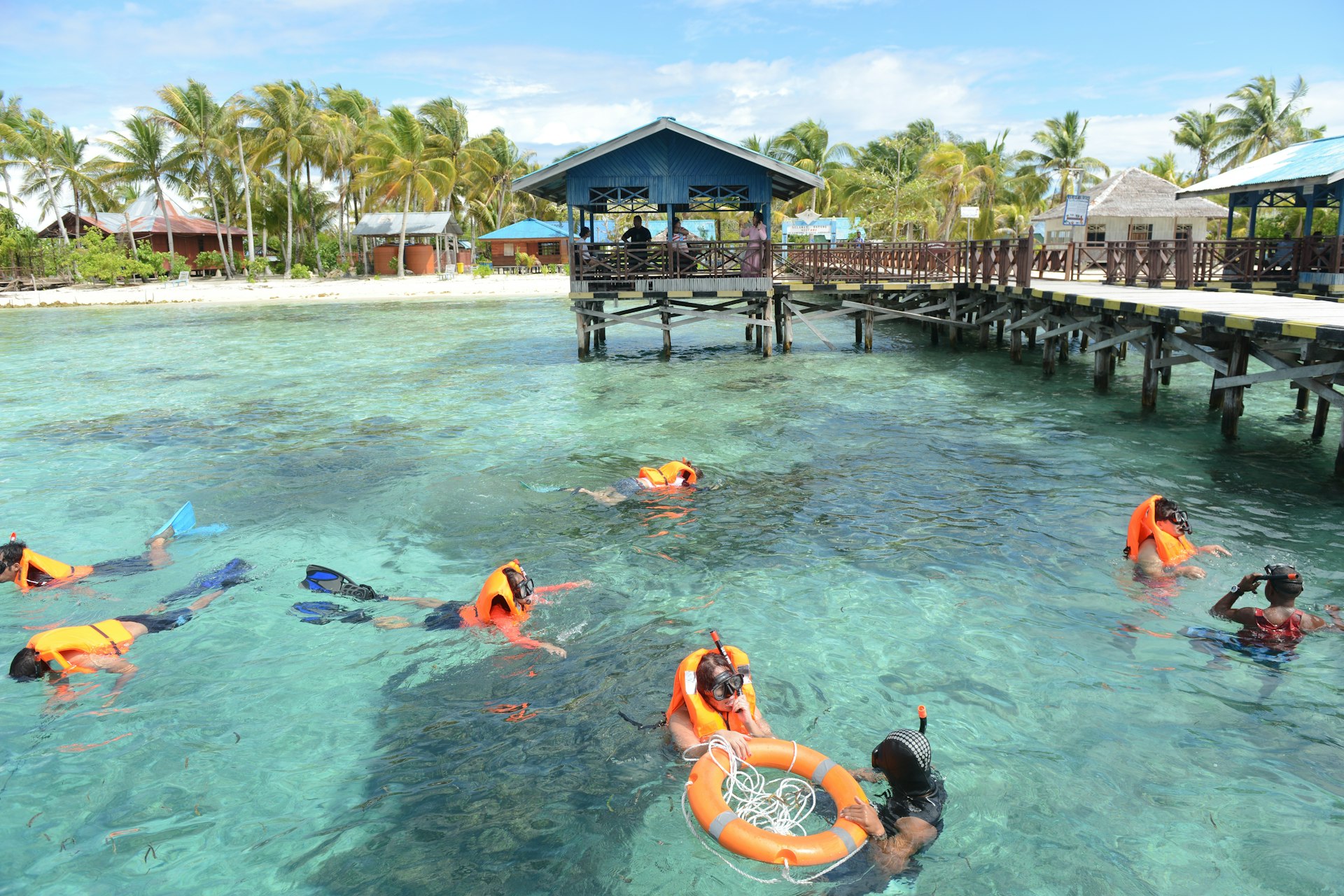
Visit Arborek Village
Tiny Arborek Village (population around 200) offers a glimpse of more traditional Papuan culture, with elders who still make a living weaving and children who have revived Papuan dancing. The people who live in Arborek (an island just off the coast of Waigeo) migrated here from the hills of the mainland in the 1930s, and their dances tell the story of the transition from being hunters to fishers. Meanwhile their woven crafts – made from the dried leaves of the pandanus tree and local dyes – often take the shape of manta rays and other sea creatures found in the nearby waters. You can frequently spot kids rehearsing dances in front of the town church, while crafts are sold directly from the homes of weavers.
Climb Pianemo Hill
Want that classic Raja Ampat shot with pincushions of bush-clad rock floating in the turquoise sea? You’ll need to climb to the top of Pianemo Hill , a hunk of honeycombed karst in the Fam Islands group (between Batanta and Waigeo) that’s covered in spindly pandanus and gum trees. Some 250 wooden steps lead through the dense vegetation up to a platform at the top, where the five points of a star-shaped lagoon come into view. Two overlooks nearby jut out over the edge for picture-perfect panoramas. You can find similar views 30km (19 miles) beyond Waigeo at Wayag , a remote collection of atolls often featured in promotional materials.
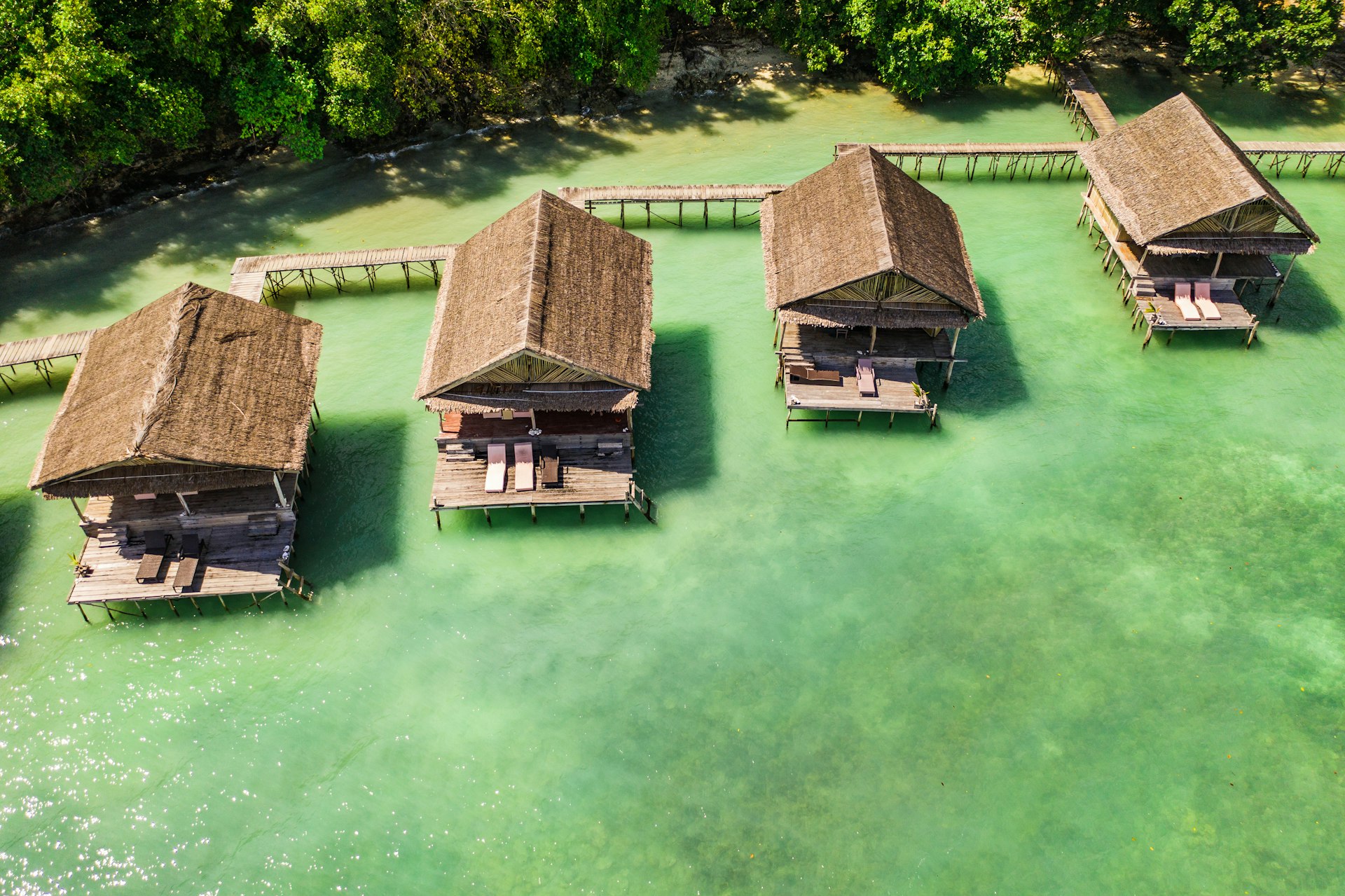
Where to stay in Raja Ampat
The quality of homestays varies.
The cheapest and most authentic way to sleep in Raja Ampat is to book a village "homestay." The name is a bit deceiving; you won’t actually sleep in anyone’s home, but rather in a bungalow nearby. Stay Raja Ampat is like the Airbnb of family-owned budget options, giving an online presence to rural accommodation providers. Most homestays come with full board, though hospitality standards and quality vary widely. Recommended options include Kordiris Homestay and Corepen Homestay on Gam Island, as well as the more remote Mandemor Homestay on Batanta.
Dive resorts range from comfortable to luxurious
Dive resorts were the first to put Raja Ampat on the map, and they remain the most comfortable – often downright luxurious – options around. Some have overwater bungalows and beach bars; others spas and farm-to-table restaurants. The best properties, such as Misool Eco Resort and MahaRaja Eco Dive Lodge , have been instrumental in safeguarding some of the most biodiverse reefs on earth through conservation initiatives and community empowerment.
Liveaboard boats are ideal if you want to explore the archipelago
Resorts and homestays typically tie you to one island, but if you want to tour the entire archipelago, there’s really no substitute for a liveaboard boat. Several Indonesian cruises include quick stops in Raja Ampat, but to spend more time here, you’ll want to book an option departing from Sorong. Most ships run five- to 11-day itineraries with a focus either on diving or land excursions. Others, such as SeaTrek , invite experts onboard for themed trips in search of whale sharks or the elusive birds-of-paradise. In general, rates for liveaboards start at around $140 per day, all-inclusive.
Getting to Raja Ampat and around
Raja Ampat lies off the west coast of the world’s second-largest island, New Guinea, which is shared between Indonesia and Papua New Guinea . Most visitors arrive by plane at Domine Eduard Osok Airport in Sorong , which lies in Indonesia’s West Papua province and receives regular flights from Jakarta . Daily ferries depart from Sorong’s harbor to Waigeo, while twice-weekly ferries head to Misool. Chartered speedboats are available at the harbor for more direct trips to your accommodation.
Local carrier Susi Air flies light planes (with a 10kg/22lb baggage allowance) from Sorong out to Marinda Airport in Waisai (Waigeo), the only airport in the archipelago.
All visitors will transit Raja Ampat Marine Park and must pay the Environmental Services Fee (700,000 rupiah). Visitors to select tourist sites will have to pay an additional 300,000 rupiah for the Raja Ampat Visitor Entry Ticket, introduced in 2019.
When to go to Raja Ampat
There’s no bad time to go to Raja Ampat, which lies on the equator and enjoys relatively consistent temperatures of between 31ºC (89ºF) and 25ºC (78ºF). June, July and August are historically the wettest months, but the monsoon seasons here are not as dramatic as elsewhere in Southeast Asia. Rainfall is often short-lived and localized. Higher winds between mid-June and mid-September can make the typically calm seas turn choppy. During this time, diving outfits may close and inter-island travel can become temporarily suspended.
Explore related stories
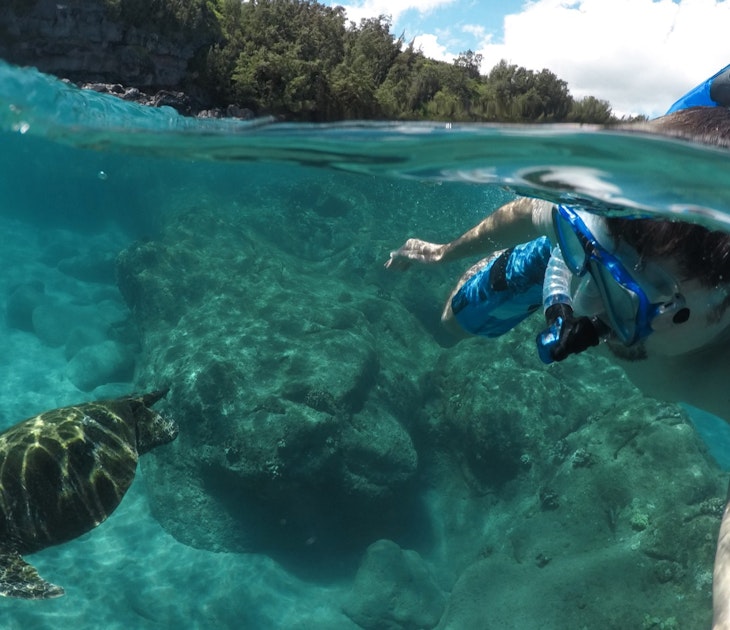
Water Sports
Mar 4, 2024 • 8 min read
From swimming in protected waters frequented by whale sharks to spotting colorful fish over a reef, here are the world's best places to snorkel.
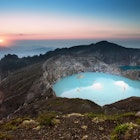
Apr 3, 2022 • 8 min read

May 20, 2024 • 6 min read
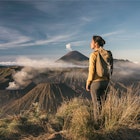
Dec 10, 2023 • 7 min read

Dec 10, 2023 • 6 min read
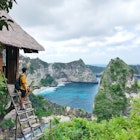
Dec 8, 2023 • 7 min read
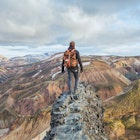
Jan 25, 2022 • 8 min read
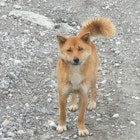
Sep 7, 2020 • 4 min read
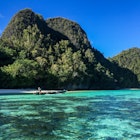
May 2, 2020 • 5 min read
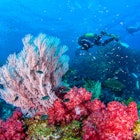
Jan 23, 2020 • 5 min read

Even though West Papua might seem rather ‘wild’ to a lot of travellers, there are some amazing and fascinating places to visit and awe in the spectacle of nature.
Places of Interest :
Pasir Putih Beach :
A soft white sandy beach with clear water with beautiful scenery, gentle breezes makes it a good place for recreation and swimming. Only 2 kilometres from Manokwari town, this beach can be reached by motorcycle, car, or public transport.
Amban Beach :
Facing the Pacific Ocean, having a wave altitude of 2 meters most of the time, this beach is perfect for water skiing and wind surfing. Located five kilometres from Manokwari town, this beach is easily accessible by all manner of transport.
Lake Kabori :
Stretching out with a beautiful panorama, it is a wonderful place for fresh water fishing; like goldfish, mujair (a kind of fresh water fish), and fresh water cat fish. Situated 20 kilometres from Manokwari town, this lake is easily reached.
Rumah Kaki Seribu (Traditional House):
This house is uniquely built by the Arfak ethnic group. Rare and unique in design, this type of house has many poles to support it. It is for this reason that the house is called Rumah Kaki Seribu (House with one thousand feet). Its walls are made of tree barks and its roof is made of coarse grass. These houses can still be found in remote places like Kebar and Anggi .
Meja Mountain and the Japanese Monument :
This mountain, looking like a table in the distance, is a preserved and protected area. Still a virgin forest, having enchanting and beautiful panorama, this area is good for hiking, and other similar sporting activities. A monument, called Monumen Jepang , has been erected on this mountain to commemorate the first arrival of the Japanese Army. Only two kilometres from Manokwari town, this place can accessed by motorcycle or on foot.
Maredred Waterfall :
Located in Pasir Putih village with a beautiful natural panorama, this waterfall has various types of flora and fauna. It is a wonderful bathing place. It can be reached within ten minutes by boat from Fak-Fak town and by walking within two and a half hours following the river bank.
Tubir Seram Island :
Located in front of Fak-Fak town, this island has amazing and beautiful natural scenery. It has a garden full of numerous colourful flowers and many types of plants. A monument, called Perjuangan Merah Putih was erected there. A mini museum was also built there to keep artifacts of historical values. It is accessible within five minutes from Fak-Fak town by boat.
Mermaid Catchment :
This unique fish is traditionally raised in Webra village. This place can be assessed by various types of vehicles.
Pre-historical Hand Palm Paintings :
Ancient reddish pictures of hand palm, weapon, and animals on the cliffs of the islands at an average altitude of 10-30 meters from sea level in front of Kokas town.
This is the coastal city and regency in Papua and has some beautiful islands.
Cape Of Cassowary :
It is a beautiful long and clean beach where there are plenty of exotic corals. It is also suitable for diving. The distance from Sorong town is 3 km and can be reached by vehicles.
Crocodile Island :
An island with slightly sloping beach, soft sand and pure water is very suitable for swimming and fishing. It is located about a half kilometre across Sorong town and accessible by speed boat.
Kafiau Island :
An island located in the middle of Dampir Waigeo Straits. Apart from its scenic nature, it has also an interesting and enchanting sea bottom that is very suitable for diving. It is about 1.5 hours to reach by motor boat from Sorong town.
Matan Island :
An island with various kinds of trees, soft sands and pure water is a place for bathing and fishing. It is accessible approximately 20 minutes from Sorong town by speed boat.
Klaijili Hot Spring :
This hot spring is found in Makbon District and is used to cure skin diseases. It is situated 60 km from Sorong town and reachable by vehicles.
Pepera Monument :
Erected in 1969, and located in the centre of the town, this monument commemorates Indonesia’s struggle to have West Papua (the former name of Papua) back.
World War II Monument :
World War II Monument. Built by the Dutch in 1948 in the center of the town, this monument commemorates the assassination of police officers and other government workers by Japanese Army.
Japanese Army Fortress :
Built in 1944/1945 and located at the centre of Kokas town, this fortress was used as a defence and hiding place for the Japanese Army during the Second World War. It can be reached within four hours by boat from Fak-Fak town.
Research Forest :
This forest has many types of plants and is used by the Faculty of Agriculture and Forestry of Cenderawasih University for research purposes. Situated seven kilometres from Manokwari town, it is accessible by motorcycle, car, or public transport.
The Raja Ampat Islands :

Further Reading : www.papuatrekking.com
Photo Credits : westpapuatrekking.com www.deepscape.com syadera.wordpress.com
West Papua Diary
Diary of west papua.
- [ October 26, 2023 ] Abdul Faris Umlati: Early Life, Career, and His Contributions to Raja Ampat West Papua
- [ October 26, 2023 ] Get to Know the Various West Papua Birth Rituals Culture
- [ September 29, 2023 ] Coral Reef Conservation in Indonesia and The Benefits of Coral Reef Social
- [ September 29, 2023 ] Ways of Restoration of Degraded Lands in Indonesia: Conservation Efforts Social
- [ September 28, 2023 ] Government Conducts Water Resource Management in West Papua Social
West Papua Travel Advice for Rookie Travelers
The region’s weak infrastructure, strict rules, tumultuous socio-political atmosphere, and almost nonexistent signal significantly restrict communication and transportation inside the area. For this reason, it continues to be one of Indonesia’s most remote and inaccessible regions. Now, leave your worry to this West Papua travel advice.

https://www.pexels.com/photo/land-beside-a-body-of-water-during-golden-hour-2499790/
West Papua Travel Advice in Raja Ampat
When traveling to Raja Ampat , you don’t want to miss the underwater beauty of Misol Island and Waigeo Island, which are always the target of domestic and foreign tourists. If you only have one day in Raja Empat, it’s best to stay in Waigeo and then take a one-day trip with the following tourist destinations:
Pianemo Hill
Pianemo Hill is a karst cluster near the large island of Waigeo in Raja Ampat Regency, West Papua. Located in Groot Fam, Saukabu, West Waigeo Islands, it takes two hours by fast boat from Sorong City to get to this place.
Pianemo is also known as the miniature Wayag. Wayag is one of the karst islands in Raja Ampat. Reaching the top of Pianemo Hill is also not easy. The first West Papua travel advice is to climb 320 stairs or about 20 to 30 minutes to reach the top.
Telaga Bintang
Only three minutes from Pianemo Hill, Telaga Bintang offers a beauty that is not inferior to other places. From the top of the hill, you will see a star-shaped headland. It took five minutes to reach the top of Bukit Telaga Bintang.
Tourists should be careful when climbing to the top of the hill. Narrow and steep roads become a challenge when climbing.
Friwen Island
West Papua travel advice in Raja Ampat is to visit beautiful beaches in the South Waigeo District. Friwen Island, the white sand beach, stretches for three kilometers. The sea is calm and clear.
That said, the beach on Friwen Island is more beautiful than Marsua Island and Kri Island. This location is suitable for diving or diving activities for professionals and beginners. The underwater panorama on this island spoils our eyes.
The Best Time to Visit West Papua
Witness the enchantment of the maritime festival in october.
The best time to visit Raja Ampat is around October. There is a large maritime festival. On Waigeo Island, an unusual occasion takes place. The festival featured a variety of exhibits, such as diving in several locales, traditional boats, and Papuan culinary delicacies.
In addition to the festival, various water sports can also be done, such as snorkeling. At that time, different types of ornamental fish could be seen clearly in the underwater garden. One of them is manta rays. They usually gather and clean themselves to look for food behind coral reefs.
Fun Diving in November-December
The rainy season starts in November-December. However, the intensity is still rare. It only happens at night. Well, from when morning until noon, another West Papua travel advice you can do is diving activities.
Some ideal dive sites include Manta Sardy, Teluk Kri, Mios Kon, Arborek, Yenbuba, and Sardines. Besides diving, you can also watch the action of dolphins and orca whales.
Yenpapir Island is the best place to watch the show. Usually, dolphins start acting in the morning or evening. In addition, there is a paradise dance that takes place every 05.00-06.00 in the morning.
Visiting Wayag in February
Wayag Island is a mainstay tourist area in Raja Ampat. The best time to visit this place is in February. Because the wind conditions at that time were not strong, the sea was rarely choppy so that tourists could cross safely.
The distance from Wayag Island to the capital city of Raja Ampat is quite far. You have to travel by ferry for several hours. However, all that will be cured when you arrive at Wayag Island.
There are clusters of rocks covered in green vegetation. Not to forget, the turquoise sea and white sand are the main attractions in Raja Ampat.
Wrapping Up
You’ve reached the end of the West Papua travel advice we have gathered for you . It is ideal to go when one of the several tribal festivals, where tribespeople gathers to celebrate their customary ways of life, is taking place.
Share this:
- Destination
- Hidden Gems
- Raja Ampat Regency
- travel advice
- west papua beach
- west papua travel advice
Related Articles
Introduction to cewers (conflict early warning early response system) in west papua.
Indonesia is a diverse country. The people come from distinct backgrounds such as heterogeneous races, cultures, languages, and religions. Hence, the country is susceptible to conflict. Conflict Early Warning and Response System is an attempt […]
The Nickel Mining that Helps The Economy Grow in Gag Islands, Raja Ampat, West Papua
The authorities reported in the regional government of West Papua that for two years, the people of Raja Ampat Regency had experienced an economic crisis due to the impact of the pandemic. Surprisingly, it did […]
The Beauty of Waisai, Raja Ampat, West Papua
When it comes to tourism in West Papua, many people might automatically think of one name. Yes, it is Raja Ampat. It is the famous spot for tourists around the world who enjoy water sports. […]

The Baliem Valley, West Papua
Baliem Valley, West Papua
As the fog clears, steep, jungle -clad mountains loom in the distance. Clouds descend into the valley as they are pierced by the rising sun, painting a picture of solitude and serenity. Up until now, I had believed places of such remote and indescribable beauty only existed in fairy tales. As I crawl out from my smoky hut in the early hours of the morning, it takes an enormous effort to convince myself that this place is even real. This is the Baliem Valley in West Papua’s remote hidden interior, a place where true adventure can still be had. A place where travelers earn their stripes and become explorers; leaving all that they thought they knew behind them. Papua will change you; come prepared.
Getting to the Baliem Valley
The Baliem Valley is located in the central region of West Papua . The task of getting here can be incredibly intimidating, due to remoteness. Do not fret, however, the journey is not as hard as it may appear. With a little patience, getting here can be fairly pain free and exciting.
Jayapura, the Gateway City
Jayapura is the capital city of Indonesia’s West Papua region. Getting here is just a matter of catching a flight from one of Jakarta, Manado, or even Makassar . Usually, the cheapest flights can be found with Lion Air’s “Batik Air.” Flights from most other Indonesian cities, apart from Jakarta, usually connect through Sorong, another city located in the far west of West Papua.
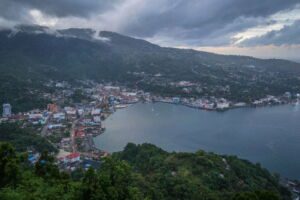
Jayapura itself does not actually have an airport. Instead, you will land at Sentani airport , which is about a 35 km taxi ride to Jayapura city itself, a journey that takes about an hour. Travelers arriving from backpacking in Indonesia will be in shock, as prices here are much higher than elsewhere in the country. Just ask the taxi to drop you off at JL Percetakan in the centre of Jayapura. Here you can find a few hotels for under $25 US per night.
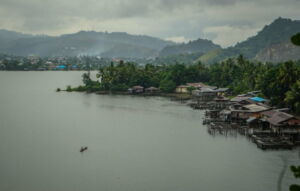
Wamena, Baliem Valley
Wamena is the main “town” in the Baliem Valley . It consists of a few overpriced hotels, a church, military base and a fairly modern airport. Getting to Wamena from Jayapura is not hard at all. On Jayapura’s JL Percetakan Street, you can find many travel agencies who can book you a ticket for next day flights to Wamena from Sentani. There are now several airlines making the trip to Baliem, so getting on a next day flight is a cinch. Again, Lion Air still tends to be the cheapest option for this.
Flying here is an exhilarating experience. The twin prop plane that makes the journey climbs up the mountains,, through puffy clouds over incredible scenery. The turbulence can be pretty intense, so get ready!
When you land you will right away be greeted by the police so they can issue you a Surat Jalan .*
* Surat Jalan: When visiting anywhere in West Papua you will require a Surat Jalan. This travel permit will allow you to access the many regions of West Papua. In Jayapura, you will very rarely be asked for one. If you plan on doing any hiking in Baliem, however you will defiantly need one. The good news is that they are free and easily obtained upon arrival at the Wamena airport. All you will need is a passport photo and thirty minutes of your time.
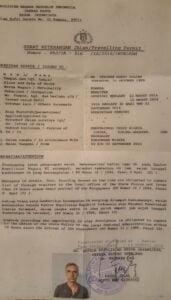
From Wamena’s airport, you can just walk as the town is very small. If walking is not your thing, hop in one of the many cycle rickshaws for about $2 US.
The 30 clans that reside in the Baliem and its tributary valleys are known as the Dani. The Dani population consists of around 200 000 people.
These days, most of the Dani speak Bahasa Indonesian , but they also speak their own dialects amongst each other. In the more remote corners of the valley, you will be greeted with the phrase “Wa, Wa,” a common greeting showing respect.
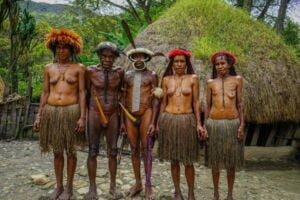
In Wamena, very few of the Dani still wear their traditional outfits, apart from a few elderly men who hang around tourist hotels; selling trinkets and posing for pictures. In the villages scattered around the valley, you can still find elder Dani men donning their penis sheath; made from a gourde. The men also wear a traditional headdress, usually made from either cassowary or chicken feathers. Along with the crown, the men pierce there septum with a pig tusk. Very rarely do you see women in the traditional grass skirt and bare chest apart from in Jinka, where they pose for pictures. On the trails in the highlands you will still see women carrying babies, pigs and sweet potatoes (usually all at once!) in a woven bag known as a noken that is carried with a strap braced on their forehead .
For the most part, the Dani and the rest of Papua have converted to Christianity. Cannibalism, nudity, and culture in general have greatly been affected because of this. One thing that still often happens is clan warfare. Villages have started conflicts with one another over wife and even pig stealing. This practice has been happening here for centuries, although it, too, is starting to die out.
Many Dani still practice polygamy, a tradition they have been practising for centuries. Another odd thing you will notice, while hiking in the Baliem, is that many of the elders are missing fingers. The reason for this is that, in Dani culture, when one loses a child, they bash a finger off with a stone to show that they have lost a loved one.
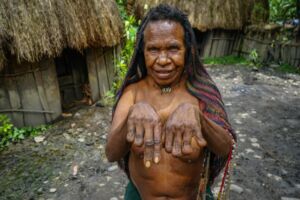
Many of the Dani still choose to live in huts, known as Honai , in closed family compounds. The Honai consists of a large grass roof and usually two levels. The top level is for sleeping, while the bottom is where the residents cook and visit together. One of the best experiences I had in the Baliem was eating sweet potatoes with the locals in a Honai.
Exploring the North Baliem Valley
Traveling in North Eastern Baliem is a great way to experience Dani culture without without having to put in a lot of effort. All the sights can be reached by local bus, or hiring a taxi. I ended up hiring a taxi as it was Sunday, which meant that none the bus’s would be operating until after church in evening. Hiring a taxi for the full day taxi cost $40 US, which I split with three other travelers. We ended up stopping at four different places in the North East.
White Mountain
The first stop was the so called “White Mountain.” This “mountain” is merely a hill that has white ocean sand running down one of its sides. The sand comes from the bellies of birds that have been migrating here from the sea for centuries, slowly building up sand deposits. To be frank, it’s an underwhelming sight. Not to mention that the local chief will demand around $15 US to enter.
Jwinka Village
Further up the valley is the village of Jwinka. Many travelers have labelled this as a “tourist trap,” as locals here dress in traditional clothing mostly just for the benefit of snap happy tourists. All locals will ask for a fee before you can take their photo, but it’s still a great way to see how the Dani here used to dress. There outfits are not just for tourism, however. Most of the men and women who are in this clothing are elders, and have just not transitioned to wearing modern clothing. The elder women will be happy to show you there, amputated fingers as well, an indication of how authentic Jwinka still is.
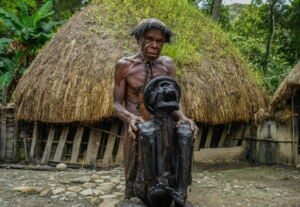
Upon arrival to the village, you will be greeted by the chief. You then will have to negotiate a price for photography, seeing the village and, of course, visiting the Wimontok Mabel Mummy. Wimontok Mabel was a powerful 18 th century warlord in the valley. His body was smoked and mummified and has been kept in the village since his death. Nowadays, his mummified corpse can be seen for a small fee of 150 00 RP.
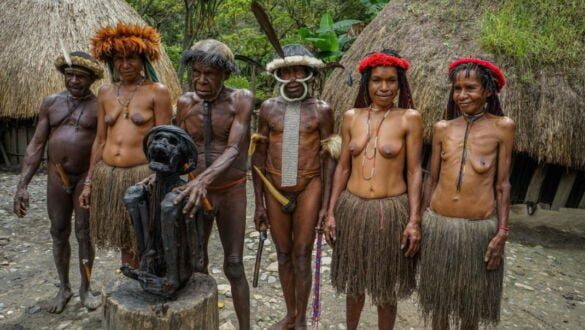
Personally, I loved seeing Jwinka Village. The mummy here was in incredible condition and the locals were very friendly… once we agreed on a price that is. As I am an avid photographer, Jwinka was an opportunity for me to get some great shots. Once you pay, the locals will proudly pose for you and then explain why they wear the jewelry and outfits they do.
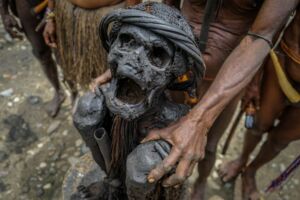
Gua Kotilola
North of Jwinka, high up in the hills is the cave of Gua Kotilola. The cave is accessed by a somewhat muddy foot path that climbs up into the hills from the village near the highway. The local chief takes you up here (for a fee of course) and shows you the different caverns.
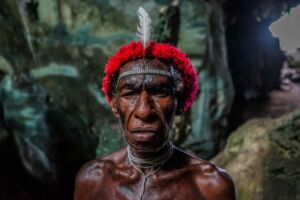
One of the caverns is particularly fascinating. As you crawl past large stalagmites, heading deeper into the cavern, it gets darker and noisier. The noise comes from the thousands of bats who call this cave home. The floor gets slippery from all of the g uano ; so be careful!
At the end of the cave, you will reach a shallow pool of water. Beyond here is where locals keep the bones of warriors from the past. The chief will not allow you to continue any further, as the spirits of these warriors guard from here on.
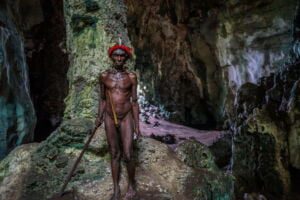
Aikima Village
Heading back to Wamena, our last stop was the small village of Aikima. Relatively hard to find because of the lack of signage, Aikima is home to the oldest mummy in the valley.
The Werapak Elosak mummy was a powerful chief who was mummified by smoking to keep some of his powers in the village. This mummy is famous for how well it was preserved. Werapak Elosak was also mummified with his penis gourde and shell jewellery. It is now approximately 300 years old! The local chief will usually allow you to see the mummy for around 150 00 RP.
I actually preferred seeing this mummy versus the one in Jwinka. The more challenging journey of getting to Aikima made it feel a lot less touristy than Jwinka. The chief had to climb to the top floor of his Honai and drag down the mummy for us to see.
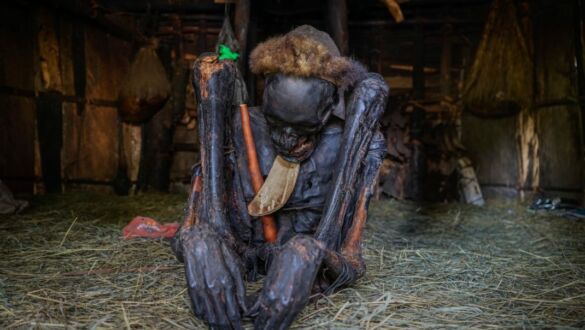
Hiking in the Baliem Valley
The engine sputters as the rusty old van pushes through the muddy road. The air is fresh, and I can see storm clouds brewing in the distant mountains…
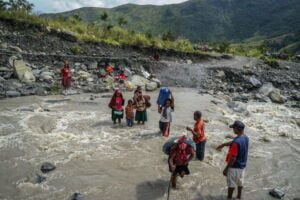
As I rode on the roof of the bus, I peered into the distant valley and contemplated what struggles may lay ahead. The Southern Valley begins to take shape in the distance. Its mountains soar high into the clouds like fortress walls. The clouds move fast, making the weather unpredictable. Finally, the bus comes to a halt, and the driver yells “Kurima!”
My crew consisted of five all together. My travel companion, Josh, from Canada, Teresa from Spain, who we met in Wamena, and our friends Harod and Natalie from England, who had been traveling with us for quite some time already. This motley crew of battle hardened travelers had no idea what was in store for them.
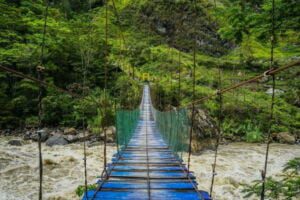
My four friends and I crawled down from the roof of the old van and we began the arduous journey. The first obstacle was crossing the Baliem River. There used to be a bridge, but it was washed away (along with good portion of the valley) a few months earlier. The current moves rapidly, and the water is frigid. A line of Papuans carrying pigs, potatoes, and miscellaneous tools made a line and held hands as they crossed. Being much taller than the locals, fording the river was a bit easier for me, but even with my height, the rivers depth was above my waste.
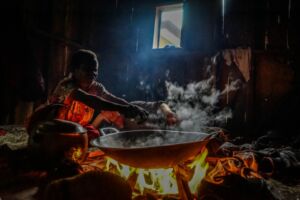
From the river, Kurima was another hour’s walk. As we entered Kurima village, we were greeted with a colourful festival. The festival (possibly a funeral) was a spectacle of vibrantly dressed locals. An archer proceeded to kill three pigs with his bow and arrow. The spectators then joined in to butcher the beasts and cook them in a bundle of smoking leaves. After only an hour of hiking we were already in the set of a National Geographic documentary.
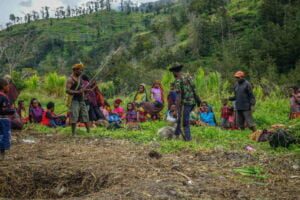
Hiking from Kurima to Kilise Village, you begin to realize how far from civilization you are becoming. The somewhat paved road ends here, and is replaced by muddy trails. Electricity, running water, and most other aspects of civilization slowly fade as you delve deeper into the wild.
My friends and I took a wrong turn and ended up having to take a secluded trail up a mountain side, covered in sweet potato crops. The extremely friendly locals were happy to point us in the right way to Kilise.
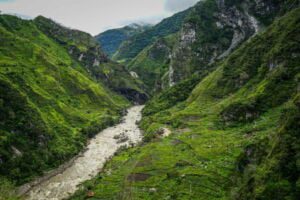
In Kilise, we asked around for food. An elder Papuan couple brought us into their Honai and let us use their firewood and cooking utensils. As the rain began to fall, we sat together on the straw floor of the smoky room together, cooking and laughing, trying to explain our cultural differences to these amazing people.
When the rain finally stopped, we crawled out from the warm, smoke filled interior of the Honai back into the stunning Baliem Mountains. The sights we witnessed while hiking from Kilise to Wamerek were incredibly jaw dropping. Clouds drifted alongside the densely forested mountains. The vertical drop on the side of the trail became daunting. As we looked down from the mountain, we could see small villages speckled throughout the valley.
Here things got dicey. The final stretch to Wamerek took us along a farmer’s trail, down the mountain side. The previous rains had turned the trail into a hazardous mess, which slowed us down drastically. We spread out as we descended, fearing a false move would bring us all tumbling down to our death. To make things worse, it began to rain again. The black clouds blotted out the sun, making this portion of the journey very frightening. After three hours of struggling down the mountain, we arrived to Wamerek; covered in mud, sweat, and blood from our many falls.
The local guesthouse took us in and cooked an incredible meal of rice, spinach, and maggi noodles. They made good use of the ingredients they had but, to be honest, anything at this point would have tasted amazing.

The next day can only be described as hell. From Wamerek to Wesagalep, the rain poured down on us as we began our three hour climb up the mountain. It was muddy, steep and very humid. Hiking here is challenging; not for the faint-hearted. Nearing Wesagalep felt surreal. High up in the clouds, you can only see a few feet in front of you. Every so often, a gap in the clouds would appear, allowing a brief glimpse of the stunning valley below.
Wesagalep is small. Only a few Honai and a single guesthouse are here. The altitude creates frigid temperatures, so living here is hard. The only people still in town at this time of day were an Elder blind couple who took us in for lunch and to dry off.
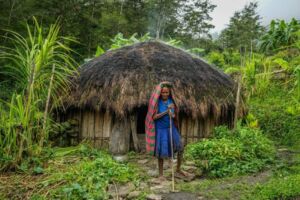
The elder man only wore a penis gourde and feathers atop his head. How he was able to survive in the rain and cold wearing only this I will never understand. When we finished our lunch, the Elder women guided us up the remaining part of the mountain to the summit.
The next part of the journey took us back down the valley to the river. We crossed through some very virgin rainforest and impossibly beautiful mountain vistas.
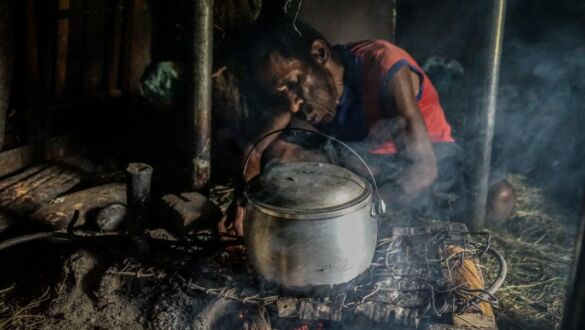
Arriving to Wuseram, we collapsed to the floor of the local guest house. Today’s hike was stunning, although painful, taking us around ten hours.
The next day to Syokosimo only took a few hours of hiking, but because the sun was shining and the valley views were clear, we took much longer. It was impossible not to stop and stare in awe at this scenery. Looking back, we could see the beast we had summited (which seemed so far away already)!
Syokosimo is nestled along the river, in the lower part of the valley, making it warm and very pleasant. This day we spent talking with the locals and learning about their culture. My fondest memory was having a cigarette, which was made from local harvested tobacco, with one of the Elder men. He wore only the penis gourde and cassowary feathers atop his head. After talking with him for some time, he brought the men in our group penis gourds which we were expected to wear…. Yes it was strange wearing only a fruit if you were wondering.
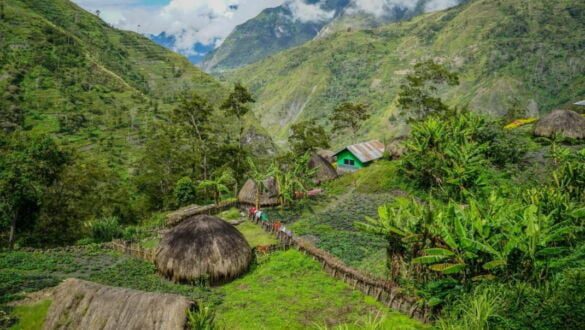
The final day we had to cross the Baliem River back to the trail we had already walked. The bridge that connects the valleys is a little less than horrifying. Every year, many people fall from the rickety thing to their deaths. Locals showed us how to cross it, which is done one by one and with extreme caution. After crossing, it was another two hours hike back to the bus stop. These two hours give you plenty of time to reminisce on your journey. Baliem Valley is not a place I am likely to forget!
Guide to Hiking the Southern Baliem Valley Trail
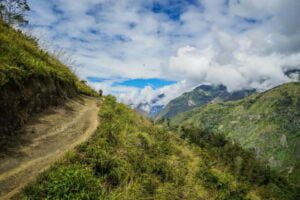
Day 1 – The first day you will have to wade across the river just before Kurima. After crossing, Kurima is about another 1-2 km along a nice paved road. Upon entering Kurima, you will be stopped by the military and asked for your Surat Jalan . From Kurima, the path becomes extremely muddy. Keep in mind that the next stop is Kilise, which is a steady uphill journey. You will reach Kilise from Kurima after 1-2 hours. The final stop will be Wamerek. Wamerek is another 3-4 hours away, the views are incredible. If you veer of the trail it can become incredibly hazardous. Take it slow, and ask locals which way to go. Its not a bad idea to split up the journey up and stay in Kilise for the night. Total hike time: 6 hours
Day 2 – I made it all the way to Wuserem this day. I highly don’t recommend doing this, however, as it was incredibly hard. I will break it up into two days for this post. From Wamerek, you will cross a very scenic bridge high above the roaring Baliem River. After this, get ready, because it’s uphill for 3-4 hours. It’s very steep, very muddy, and not the most pleasant experience. I was swearing to myself almost the whole time! After enduring all this pain you will reach Wesagalep. Wesagalep is high above the clouds, meaning that it’s cold here. If you decide to stay, make sure you have the gear for it. Total hike time: 5 hours
Day 3 – From Wesagalep, don’t follow the obvious trail, which just leads to some potatoes fields. Ask the locals to show you up the mountain. After another 1-2 hours of more painful, uphill, muddy trail, you will finally begin to descend. The one hour descent is steep, so be careful. Unfortunately, you must go down all the way to the river, and then back up another mountain pass. The climb takes about 1-2 hours. Finally, it’s all downhill form here all the way to Wuserem. Total hike time: 6 hours
Day 4 – This was my favorite day. The views are absolutely beautiful as you head back down into the valley towards Wamena. You will pass through many small villages on your way to Syokosimo. The wide, easy trail is mostly downhill and constantly provides jaw dropping views. Ask locals to point you in the right direction, but the trail is quite straight forward. Total hike time: 4 hours
Day 5 – The final day you have two options. The first is to head back the same way you came along the river and cross the rickety, scary bridge (one by one). This will drastically cut your hike time down. I chose this way as it only took 4 hours back. The bridge was very exciting as well! If you want more villages and excitement, cross the river right at Syokosimo and head up the mountain. You will be rewarded with more scenery and villages. This trail takes about 6 hours.
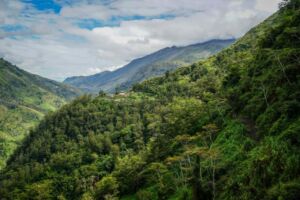
Preparing to Hike the Baliem Valley
When people refer to hiking in the Baliem Valley, they are usually referring to the Southern Baliem Valley . Here, the culture is more preserved and the villages have kept more traditional than elsewhere in the valley. Visiting here comes with its challenges, however. It’s very remote and requires some planning. Here are some frequently asked questions I have gotten:
Use a Guide, or Go Solo?
This is quite possibly the most frustrating aspect to visiting the valley. Locals will tell you its impossible to hike without a guide. They will tell you that the trails are too dangerous, navigation is very confusing and that there are no amenities. To be fair, they are not exactly wrong in saying this.
Using a guide can really help with all of these issues. Guides can arrange meals, translate, arrange porters and make the experience a lot more genuine. The catch however is that a guide will cost you at least $50 – 100 US per day, depending on the experience of the guide. There is also the risk getting stuck with an uncertified guide who turns out to be just some average joe looking to make a quick buck. If you decide to take a guide, sit down with him and tell him your expectations. Talk with more than one guide so that you can decide who suits your needs best.
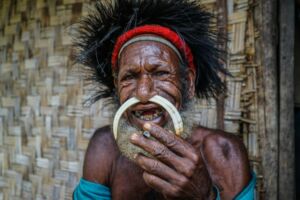
Going solo into the Baliem valley is a possible option as well, even though locals will tell you it’s not. There is plenty of local transportation to the trail head, and the trails are fairly easy to navigate, especially if you have a detailed map or GPS. Locals in the South Valley are happy to point you in the right direction as well. If you need to cook, you can stop in any village and offer a bit of money to use the fireplace in a traditional Honai house. Along the trail, many of the villages offer very primitive guesthouses for you to stay in.
What Gear to Bring?
Hiking here is extreme. It can be hot and humid one hour, freezing the next. It can be wet, cold, dry or boiling hot. It’s almost impossible to be fully prepared. The gear I brought was probably not enough, but it served me well. Here are a few items that helped me out immensely!
Fjalraven Backpack – Great size and built strong for crazy hikes like this. It can be waterproofed with the Greenland Wax
Fjalraven Jacket – Light and waterproof once it’s waxed with the Greenland Fjallraven Wax.
Greenland Wax – Amazing for waterproofing any cotton material.
Lifestraw and Bottle – enables you to drink any of the river and stream water safely… you need this one for sure!
Merino Wool Base Layer – great for keeping warm at night, its light and amazing!
Nomad Solar Panel – No plugins or electricity out here.. This panel charged my camera and phone in one hour.
Maps.me – free app that has all the villages and trails marked on an offline GPS. Amazing!!!
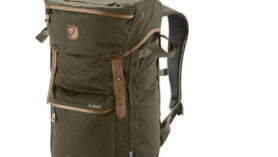
How Many Days Does it Take?
This largely depends on you, your fitness, experience, and weather conditions. The average person can complete the circuit through the Southern Baliem in 5 – 6 days. This much time will allow you to take things slow and enjoy the hike itself. Any less time and you will have to push yourself physically. The distances are not far here, but it’s hot, humid, and the vertical climbs are endless.
The weather is very unpredictable so come prepared for muddy trails that can delay hiking times by hours!
If you only have a limited amount of time, then opt for just hiking to a few of the entry villages. After one you head deep into the mountains, and getting back fast will become almost impossible.
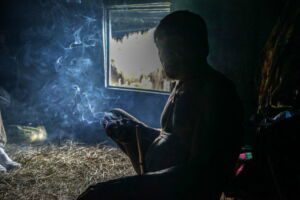
How Much Does it Cost?
If you factor in a guide, food, transport, porter, and all the extras, you can expect to pay about 700 US for 5-6 days. You can greatly reduce the price by brining your own food and equipment, not using a porter, and even eliminating the guide.
I did the trail on my own and brought my own food and equipment. My daily costs were about $15-20 US per day. So compared to the $700 US packages the guide offers, I did it all just over 100 US for the five days.
Accommodation and Food
This is quite possibly the most confusing and misunderstood part of the hike. Guides will tell you it is impossible to find accommodation on your own. This is, of course incorrect. Pick up a copy of the Lonely Planet: Indonesia . In the Papua section, you will find all the towns that offer official accommodation. When entering these towns, the owners will find you right away and direct you to the guest houses. If you want to stay with locals in a Honai, it will take some negotiating and some Bahasa language skills.
The guesthouses are very basic, usually offering a room with a carpeted or concrete floor. They will provide blankets to lie on, and sometimes a blanket to cover up with. It’s best to bring a sleeping bag or your own blanket.
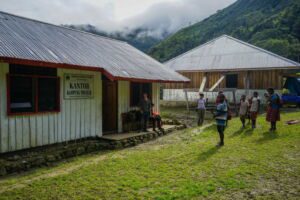
The availability of food and the means to prepare it is also misunderstood. Guides will say that you need all your own cooking equipment and food. With regards to cooking equipment, this is false. If you don’t mid using old pots and pans that are slightly unsanitary, then every single household can provide you with firewood, a fire and everything you’ll need to prepare meals.
You should bring some food, however. The locals mostly eat sweet potatoes, rice and sometimes spinach, so brining some comfort food is defiantly worth it. Trying the local food is a great experience though. Don’t miss out snacking on eating sweet potatoes around the fire while sharing stories!
Transport to Southern Baliem
Transport to the Southern Baliem valley is very easy to find. You can take a hired car for around $30 – 50 US. Or, you can just as easily hop on a bus from the Misi terminal. Riding the buses are a great experience! You can ride up top with the potatoes and vegetables for great mountain views. The bus only costs $2 US: a real bargain.
The trailhead begins in the town of Kurima… well, about 1km before Kurima. This is because the bridge that used to allow the bus to get all the way to Kurima is now gone from flooding. So the bus will drop you off near the river in which you must wade across. The journey to this point takes about 45 minutes.
West Papua is, in general, a safe place. But, things do happen here. Free Papua rebels or the OPM frequently have violent clashes with the government. Protests and demonstrations can also violent, usually resulting in deaths. Tourists are not being targeted, but kidnappings have happened in Baliem.
The real dangers here would be aggressive driving, drunken hooligans, muggings, and disease. Muggings are rare, but always be cautious at night. Its best not to hike at night. Aside from the danger of being a victim of a crime, the chances of getting lost increase exponentially at night. Papua is very remote and undeveloped; getting lost is a very serious and real danger.
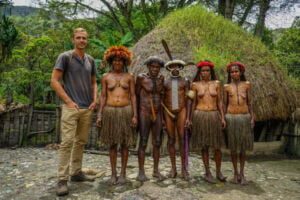
Taking anti malaria pills and using bug repellent is essential. Malaria, Dengue and other mosquito borne illnesses are rampant. Sleeping in traditional houses, you will often get hundreds of bug bights that don’t always heal well.
Get your vaccines up to date, avoid drinking alcohol as its prohibited, and don’t go looking for trouble at night.
Baliem Valley Video
useful information.
Location: Baliem Valley, West Papua, Indonesia
Language: Bahasa, Dani
Guide Book: Lonely Planet Indonesia
Flights: Lion Air flies from most major cities in Indonesia to Jayapura, and then on to Wamena
Top Tips: Plan ahead, travel here should not be taken lightly. West Papua is not a place to just show up to, there are many issues you will face as tourism is not developed in any way.
Check out what I carry in my bag Here!
Stephen Gollan
Uncharted Backpacker is a glimpse at the past eleven years of globetrotting I have done. Now at over ninety countries I share my travel knowledge for you so you too can travel the world and see what wonders it has to offer.
Related posts
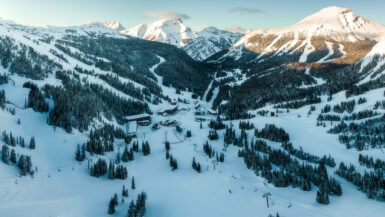
Learning to Ski at Sunshine Village, Banff
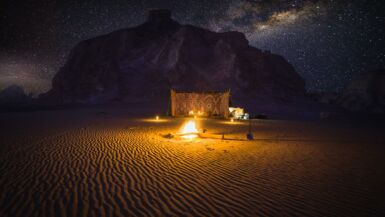
Medium Rare Travel Blogging and Writing 2022
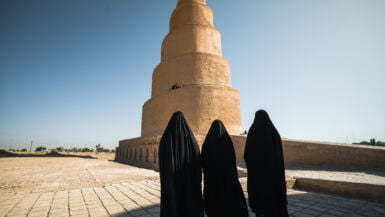
Travel Iraq Guide
Leave a reply cancel reply.
Your email address will not be published. Required fields are marked *
12 comments
Woowwww amazing post with amazing pictures 🙂
Definitely I must go back to Indonesia, there are so many great places that I have missed 🙁
Have a nice day,
Haai, thank you for writing about wamena…. been living here for 2years.. But it’s in Papua. Not west papua 🙂
Awesome pictures, Im headed that way late 2017 and will use your post to do my planning, thanks!
Great pictures! Thanks for the post, it will help me for my trip later next year!
Hi Stephen,
Just coming back from Baliem Valley, It was amazing, sure! A bit hard, being alone, but I feel really great now. Just a remark about them being barely naked and not feeling coldness: they cover their skin with pig fat, to keep warm.
Have nice travels,
Wow, what a experience you must have had. Very inspiring – thanks for sharing!
https://carrieproject.com/
Hi, Stephen! Thank you so much for all those informations! Me and my wife are planning an independent hike in Baliem Valley for october 2017 and the information we can find on the internet is never enough! A question, please: do you have the gps track from your hike or did you just use maps.me? Thank you and good luck!
Adrian ([email protected])
Thank you for sharing this amazing information. Welldone you really are an adventurous guys!! Looking forward to visit Papua .
Hi I am going to the Baliem Valley in a couple of days , of course indipendently! Any tips would be great I only find your blog/web now Thanks in advance Mike
I have really enjoyed your blog – I did almost the same trip when I was 21 I am 46 now and it’s interesting to hear that the area is still very much the same. I loved my trip which I took with a travel company that organised guides , routes etc. I am glad that I did it and glad that people still are visiting this beautiful place.
Congratulations for your blog, is fantastic and thank you so much for share your experience and all the information!
Regards from Argentina!
It’s really wonderful journey. As Indonesian, I really appreciate it. Thank you for coming and also thanks for your kindness to explore Papua. It was absolutely inspiring. Great job!

Plan Your Trip to West Papua: Best of West Papua Tourism

Explore West Papua

Explore our great value fares
Essential west papua.
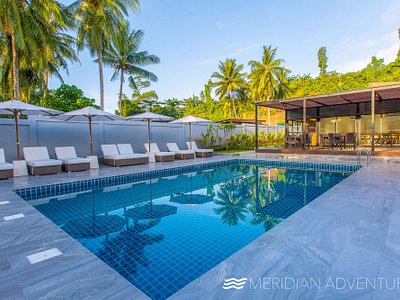
West Papua Is Great For
The great outdoors.
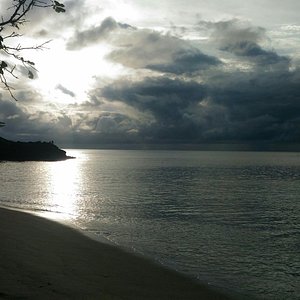
Sand & surf
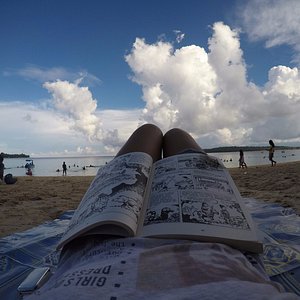
Young Pioneer Tours

How to Get to West Papua
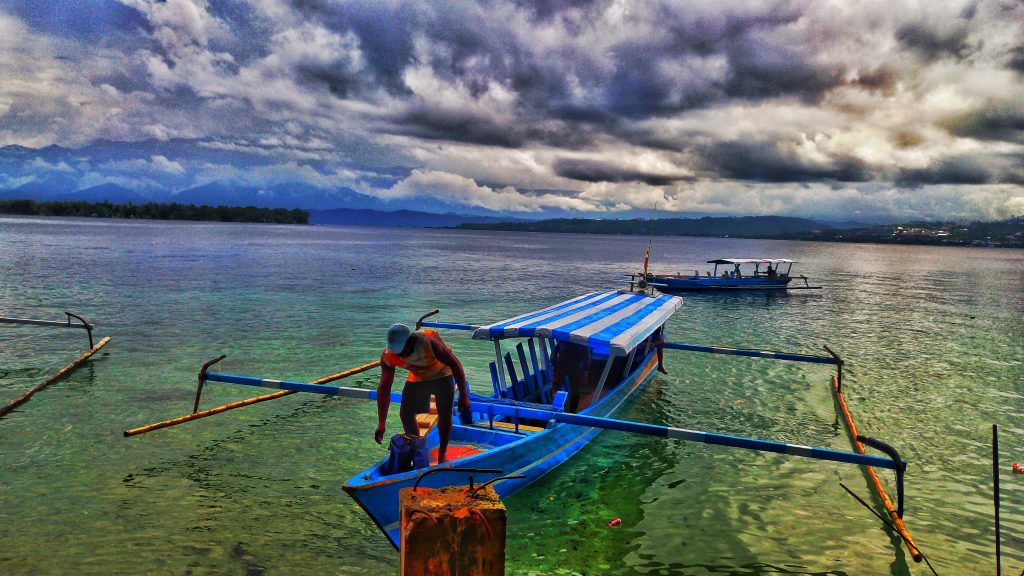
As some of you might know, YPT runs tours to West Papua now. On our trip, we start from Bali in Indonesia and fly to Jaypura, the ‘capital’ of West Papua. But is that really the only way to get there?
What you need
First of all, it doesn’t matter if you can catch a plane to West Papua. If you don’t have the right documents, you’ll get turned away from the border immediately. Since West Papua is part of Indonesia, the first thing you need is permission to go to Indonesia! That requires a look at the visa policy.
So long as your passport is valid for six months and you are a passport holder of the listed countries, which includes all of Europe, America, Canada and many more, it is possible to visit Indonesia visa-free for thirty days through 29 airports, 88 sea-ports and 7 land border crossings. Only problem with this policy is that you can’t extend your stay or get a different kind of visa. Applicable to many more countries is getting visa on arrival , which allows you to extend your stay for another 30 days for a fee of US$35.
For those who want a multiple-entry visa, want to extend their visa multiple times or belong to a select few countries, it’s necessary to apply for a visa directly at an Indonesian consulate. The countries that require a visa in advance are Afghanistan, Cameroon, Guinea, Israel, Liberia, Nigeria and Somalia. Also North Korea, in case you happen to hold that passport.
How to get to West Papua
Okay, so you’ve got your Indonesian passport, now you gotta get to West Papua. As it happens, there are three main points of entry. By land, by sea and by air. Let’s go over them all individually.
Travelling by Air
We’ll start with air, because that’s how most people get there. Your main point of entry will be Sentani airport, Jayapura. It’s impossible to fly into West Papua via another country, with the sole exception of recent flights from Mount Hagen in Papua New Guinea. Your main flights will be found in Jakarta, Makassar, Ambon and Bali, though flights do occur from other airports around Indonesia. From Jayapura, it’s possible to fly to several other airports around West Papua. On a limited level, it’s possible to fly from other parts of Indonesia to these airports, particularly Fakfak, Sorong and Timika.
Travelling by Sea
Indonesia is served heavily by Pelni liners, owing to the sheer number of islands that make up the nation. These liners are your main method of sea transport into West Papua. The main entry point is the coastal town of Sorong, to which five liners travel every two weeks from Maluku, Sulawesi, Kalimantan and Java before continuing onward to Jayapura with several stops along the way.
Travelling by Land
As it happens, there is only one land border in West Papua, that being with Papua New Guinea. While there’s technically many ways to cross between the two, only one entry is known to be open to foreigners. The Skouw – Wutung border crossing between Jayapura and Vanimo, Papua New Guinea is open between 8am-4pm Indonesian time. While there is no visa on arrival for travelling into Papua New Guinea, there is the possibility of a 30 day entry visa on arrival when travelling from Papua New Guinea to Indonesia.
Surat Jalan
Surat Jalan are travel permits required for visiting West Papua. The region is comparatively volatile for Indonesia, so if you decide to move beyond the main coastal towns, it’s important to pick up these permits. You can get them in a day in Jayapura and Biak, which are typically themselves permit-free, allowing freedom of travel. To visit other parts of the island, you’ll need to apply, list the places you’re travelling to and pay 5000 Indonesian rupiah. Less than a dollar, typically. Upon arrival in new destinations, you need to get the permit stamped at the local police station. I should emphasize, you do not need a permit to get to West Papua, only to travel around.
If you want to get to the famous area of Raja Ampat, a special fee has to be paid. There’s an office opposite the airport at Sorong or Waisai, where the permit costs around 1 million rupiah. Or $70.
That should largely cover it! If you’re at all interested in visiting West Papua for yourself, keep this advice in mind. Or sign up for our tour there!
About Post Author

Dominic Perry
See author's posts
- Suspendisse tincidunt nunc nec
Tripadvisor
Latest news.

World Cup dream alive as DPR Korea beat Syria

Thailand extends its visa policies from June 2024

YPT group attends epic Rammstein concert in Belgrade on May 24th 2024

An American in South Korea Heads North (Part 1)
- Terms & Conditions
- Payment Policy
- North Korea Tours – 2017 Tours
- Tour Extensions
- Independent Tours
- North Korea FAQ
- Our Terms and Conditions
- Our Payment Policy Terms
©YoungPioneerTours.com 2024. All rights reserved.

Sorong, West Papua
Sorong is the city of West Papua , well known as the gateway to Raja Ampat islands that are famous for diving in Indonesia . Therefore this place serves as a port for travelers to get to the remote West Papua and then connect onwards by ferry or boat to Raja Ampat.
The town Sorong is located at the ‘beak’ of the Papua’s bird’s head peninsula, where you would take as a departure point to Raja Ampat. It serves as an important port for West Papua in Indonesia.
The word Sorong meant “deep and turbulent sea” in the local Soreri language. Sorong is well surrounded by mountains, hills and protected forests all around.
Where is it
At the tip of the beak of West Papua bird’s head peninsula.
Gateway to Raja Ampat, one of the best diving sites in Indonesia.
When is the best time to go
As most travelers come to Sorong to go to Raja Ampat, the best time to come here is during the good weather for diving which is the dry season of September to June .
What to see
People of Sorong, West Papua – one of the nearby beaches that are worthy for some chilling and sunbathing
View from Stone Hill – climb the Stone Hill nearby for a panoramic view of Sorong city, beaches and sunsets from the top. This hill dotted with Dutch colonial houses can see as far as the Crocodile Island.
Tugu Arfak – a war memorial to the Japanese. The complex has an obelisk, a bronze Shinto deity and memorial plaques.
Watch birds of paradise – the famous endemic birds of the Papua can be seen by taking a boat to Batanta Island (about 3-4 hours). You may also stay overnight at Waigeo or Sawinggrai in a tent or local huts while catching a glimpse of these birds.
What and where to eat
Sample some of the local unique West Papua cuisine , which is diverse yet somewhat similar to other parts of Indonesia. Go for the food at stalls around Sorong and eat food like Bakso, Pangsit Solo and Es Teler.
Where to stay
In Sorong you will find some good value and high quality hotels, like the popular Swiss-belhotel Sorong * to some sparse choices of budget places. If you head out to Raja Ampat quickly then it will be better to stay out there where you can choose from many dive resorts of homestays.
How to get there
Fly into international airports in Indonesia such as Jakarta , Surabaya or Bali (Denpasar) and then connect by domestic flight to Sorong in West Papua. Sorong Airport is also known as Domine Edward Osok Airport. Some of the Indonesian airlines that fly to Sorong, West Papua are Garuda Indonesia, Merpati, Sriwijaya Air, Lion Air and Batavia air while international Airlines is Silk Air.
How to get around
This town though seem remote is actually one of the fastest growing cities in Indonesia. You can get around in taxi, chartered van and also the usual becak for shorter distance. Angkot are also available just like everywhere else in Indonesia.
Where to go nearby
Pulau Raja Ampat (islands) of course, for most is diving but there are also many things to see and do in Raja Ampat . It is part of the world’s Coral Triangle which is known for housing more than 3000 species of fish and other extraordinary habitats that breeds the biodiversity of its marine life.
Travel Tips
Do not need to stay here for long as there are not much things to do in Sorong, so try to arrange to escape to Raja Ampat islands as soon possible!
Fascinated by Indonesia, Rachel hopes to bring the best Indonesia Travel Guide to independent travelers so that they can enjoy what Indonesia has the best to offer. Being an independent wanderer herself, Rachel knows what it takes to make a good, fun-filled yet responsible independent traveling. So let’s join her to discover wonderful Indonesia together.
Related Posts

The Ultimate Guide to Togian Islands, Sulawesi
Togian Islands (also known as Togean Islands) are like islands lost between the midst of…

The Ultimate Travel Guide to Bogor – things to do and more
In this travel guide, we will take you on a journey to explore the best things to do in Bogor. Whether you are an adventurous explorer or a laid-back traveler, Bogor has something to offer everyone.
Guide to Diving Wakatobi National Park, Sulawesi
Wakatobi National Park, a collection of islands that may sound familiar to many but somehow…
Guide to Diving Raja Ampat, Papua
Voted as one of the best diving spots in the world, Pulau Raja Ampat /…
Baliem Valley, Papua (Irian Jaya)
Baliem Valley, sometimes known as the Grand Valley, in Indonesia is the most accessible gateway…
Leave a Reply Cancel reply
Your email address will not be published. Required fields are marked *

Papua Travel
True development starts with passionate initiatives by Papuans themselves.

FOUNDATION SDSP
Sustainable Development Papua Barat
The Foundation for a Sustainable Development in Papua Barat (SDSP) was founded from private initiative in 1995 and is a Dutch NGO run completely by volunteers.
SDSP supports projects sprung from local initiatives in West Papua – whilst preserving their own identity and culture – that contribute to a sustainable society in which health care, education, agriculture, housing and nature conservation are organized in an effective manner.

DPD HPI PAPUA BARAT
West Papua Guides Association
Most of the Papuan based network partners are represented in the Regional Leadership Council (DPD) of the Indonesian Guides Association (HPI) of West Papua Province. The aim of DPD HPI is to support and promote tourism in West Papua i.e. by certification of tourist guides in the Arfak Mountains, Raja Ampat, Sorong, Tambrauw, Kaimana and Manokwari.

RAJA AMPAT MICRO TOURISM
Local people benefit
The Raja Ampat Micro Tourism project is determined to let local papuan people benefit from their own efforts.
Their website is dedicated to a local initiative, whereby the local papuan people offer their homestays to the daring traveller. They do this in a unique form: the package deal. The package deal means that your trip to R.A., your stay there, and all the trips you make there, are organised for you, from the moment you arrive in Sorong, untill the moment you return to Sorong. On their website a lot of useful tips can also be found.

CHARLES RORING
Guide and blogger
Charles is an experienced guide that organizes eco-tours for visitors who want to experience trekking, camping, wildlife and birdwatching in the tropical jungle of Sorong regency, the Tambrauw mountains, snorkeling tours in Raja Ampat, whaleshark watching in Kaimana or customized trips to the Koroway tribe.
Charles also writes blogs on his website wildlifepapua.com to promote eco-tourism and share his experiences travelling through beautiful West Papua.

Shita Prativi
Birding Eco Tour Guide
Valentina Shita Prativi of Magnificus Expeditions, linked to her renowned Papua Bird Club , uses the power of ecotourism to fuel the conservation of the forests and birds and the development of rural communities of West Papua, Indonesia.
Your tour with Magnificus Expeditions directly benefits the forests, birds, and communities of Papua.

ZETH WONGGOR
Zeth is a highly experienced, self-trained bird guide who has led bird watching tours in the Arfak Mountains since 1994 and has worked with, among others, Sir David Attenborough.
His profound and abundant knowledge of the wildlife of his home region has established his reputation as the most reliable and successful guide in the Arfak area.
Send Zeth a SMS message

TRAVEL PAPUA
Customized package tours
TravelPapua is a Dutch-Papuan run Tour Operator specialised in customized packaged tours in any part of Papua and West Papua Province. Their mission is to preserve the culture and nature of Papua through out travelling. Working directly with local Papuan guides and communities is their top priority.
WORTH A LOOK
Conservation international.

Protecting Marine Environments
In 2004, Conservation International forged an unprecedented collaboration with The Nature Conservancy, the World Wide Fund for Nature and numerous local partners to sustainably manage coastal and marine resources in the Bird’s Head Seascape.
In Bird’s Head Seascape , CI is working to protect the coral reefs and mangroves — the life support system of the Indonesian region of West Papua.
The Nature Conservancy

Protecting nature. Preserving life.
The Nature Conservancy has been actively working with local government, communities and other partners like World Wildlife Fund and Conservation International toward Raja Ampat’s protection for the past decade.
Their main goal: to ensure the archipelago remains one of the world’s most biodiverse regions while sustaining the valuable natural resources Raja Ampat’s people need to keep their livelihoods.
RARCC conservation

Research and Conservation Center
RARCC stands for Raja Ampat Research and Conservation Center and has been taking the initiative introducing conservation and community related projects in the Raja Ampat since 1993.
Since RARCC was established, they have formed close working relationships with Conservation International, The Nature Conservancy, WWF and some of the local NGO’s. They take initiative in conservation and strive to create alternatives among others in the form of sustainable marine tourism industry initiatives.
Stay Raja Ampat

Website portal
Stay Raja Ampat is a non-commercial, not-for-profit website created to help travellers and locals in Raja Ampat.
Staying in Raja Ampat accommodation that is owned and operated by local people provides a unique cultural experience at an affordable price. You’ll be supporting the local economy and empowering the traditional owners of Raja Ampat in their efforts to preserve both their environment and their way of life.
CONTACT FORM
Email Address
Introducing Papua: Your Travel Guide

Papua, formerly known as Irian Jaya, is the second largest island in the world. The territory is split in half between Indonesia and Papua New Guinea. The Western side of the island is then split again between the two Indonesian provinces of Papua and West Papua. Of the two West Papua is the more popular tourist destination.
Just off the coast from Sorong, Raja Ampat is slowly emerging as a tourism hotspot. The region has long been famous with divers, because of the picturesque landscapes and biologically diverse coral reefs. However, the difficulty in getting to the area ensures that for the moment at least the number of tourists is just a trickle and not a flood. Should Sorong Airport ever open up to international flights you can be sure this would change.
To the east is the province of Papua centred on the provincial capital of Jayapura. Very few tourists visit this region and those that do head for the highlands. The terrain between coastal Jayapura and Wamena is so difficult to traverse that native Papuans identify themselves as coming from the coastal regions, where travel is relatively easy, or the highlands. It is only since the WW2 that travel between these two areas has been possible.
Exploring the highlands of Papua you quickly realise just how isolated this region is and for how long. Elder locals villagers walk naked along the road, their private parts covered in traditional Kotekas while women carry their goods in bags they wear on their heads. For travellers looking for a real ‘off the beaten track’ adventure Papua really is the final frontier.
Transport and Infrastructure
Travelling around Papua is extremely difficult. The island is huge with unforgiving terrain. The easiest, and in many cases the only, way to travel between places is by boat or plane. Unfortunately air safety in Papua is poor and crashes are all too common. The combination of poor infrastructure and huge distances makes Papua an extremely expensive tourist destination.
Flying is the most convenient and fastest way to get to Papua. Garuda Indonesia and Lion Air both run routes to Jayapura and Sorong with transit in Makassar. Keep in mind that due to political unrest Papua is one of two special regions in Indonesia. If you are a foreigner you need to register with the police within 24 hours of arriving in a city. This is true for both the provinces of Papua and West Papua.
Papua: Local and City Guides
To help you arrange your trip around Papua we collected a selection of our most useful resources for exploring the island. You can find a variety of city guides, hotel recommendations and itineraries in the links below. We hope you find them useful for arranging your holiday.
[su_row][su_column size=”1/3″] Raja Ampat Raja Ampat Travel Guide How to Arrange Your Trip [/su_column] [su_column size=”1/3″] Baliem Valley Baliem Valley Travel Guide [/su_column] [su_column size=”1/3″] Sentani Things to do Around Sentani [/su_column] [/su_row]
Pin It on Pinterest

Where to stay
Where to go, for international travelers.
- ReImagine Papua New Guinea
- Where to Eat
- Itineraries & packages
- Snorkelling
- Bird Watching
- VISA, CUSTOMS & QUARANTINE
- Getting Around
- Overseas Missions and Posts
- Learn the Language
- Safety and Health
- Industry Partners
- COVID19 - Travel Advice
- Wantok Specialists
- Our Organisation
- Our Partners
- Research & Statistics
- Projects & Programs
- Resources & Media
- Plan Your Trip
- Visa & Customs Information
- Brochures & Guides
Papua New Guinea's Official Travel Site

Getting to Papua New Guinea
850+ Languages
Hundreds of different dives, discover papua new guinea on foot, 400+ species, top things to do.
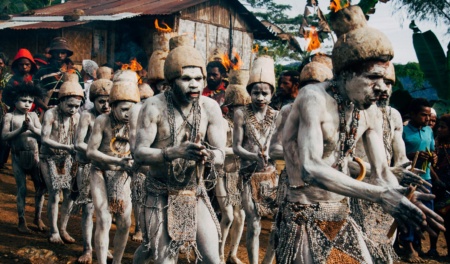
" * " indicates required fields
- All Activities
- Interactive Map
- Travel Tips
- Visa, Customs & Quarantine
- Wantok Specialist
- PNG Tourism Promotion Authority
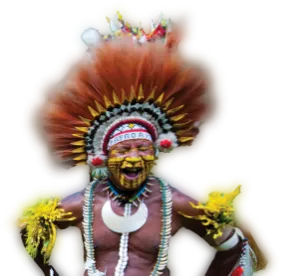
- Plan your trip
- Where to eat
- Itineraries & Packages
- Attractions
- Where to Stay
- Visa, Customs & Quarantine
- Safety & Health
- COVID19 – Travel Advice
- Tourism Promotion Authority
- Research & Statistics
- Projects and Programs
- Resources & Media
- Australia and New Zealand
- United States and North America
- United Kingdom

COMMENTS
NOTE: For your own safety, please consider your government's travel advice before deciding to travel to West Papua. By Alex Hatton, World Nomads Contributor - Wed, 12 Jul 2023 Related articles. 10 Indonesian Islands That Could Be The Next Bali. Here are 10 gob-smackingly beautiful Indonesian islands you must see before they're turned into the ...
Until 2001 it was called Irian Jaya, although this name is very unpopular among locals who prefer West Papua. Confusingly, since 2003 West Papua has also been officially divided into two Indonesian provinces: West Papua and Papua. Travel. The first thing to know about travel in West Papua is that everything (guides, transport, permit) can be ...
Travel Papua is located in Manokwari and we offer customised tours in Papua, Indonesia. We embrace Eco - Tourism and we show respect to nature and the needs ... This was an intense but well organized trip to a series of interesting places in West Papua: Anggi lakes, Arfak mountains, Manokwari, Kaimana, Triton Bay, Sorong, Malagufuk, Raja ...
West Papua Travel Guide. West Papua marks the eastern extremity of the Indonesian Archipelago. As the western half of Papua, the world's second biggest island, it's a sizable chunk of land with only a relatively small population of less than 880,000. It's a land of contrasts - an exceptionally beautiful province boasting vast tracts of ...
West Papua. Indonesia, Asia. The province of West Papua chiefly comprises two large peninsulas - the Vogelkop (also known as Bird's Head, Kepala Burung and Semdoberai) and the more southerly Bomberai Peninsula - and several hundred offshore islands. The attractions here are primarily natural - above all the world-class diving and ...
Not many people travel to West Papua and the development in the area goes slowly which makes it a place you will not find anywhere else in the world, so pristine and beautiful. There is not much information available online or in print and the flight connections are scarce. So we summarised our favourite 2 -3 weeks West Papua itinerary here.
Raja Ampat lies off the west coast of the world's second-largest island, New Guinea, which is shared between Indonesia and Papua New Guinea. Most visitors arrive by plane at Domine Eduard Osok Airport in Sorong, which lies in Indonesia's West Papua province and receives regular flights from Jakarta. Daily ferries depart from Sorong's ...
Located on the western end of the island of Papua and the furthest eastern province of Indonesia, West Papua is often referred to as the last bastion of adventure travel in the archipelago. Don't let that deter you from travelling there because as a province it has so much to offer tourists with all manner of tastes in travel.
The first West Papua travel advice is to climb 320 stairs or about 20 to 30 minutes to reach the top. Telaga Bintang; Only three minutes from Pianemo Hill, Telaga Bintang offers a beauty that is not inferior to other places. From the top of the hill, you will see a star-shaped headland. It took five minutes to reach the top of Bukit Telaga Bintang.
Location: Waigeo Island, Raja Ampat Regency, West Papua, Indonesia. Contact: +62 821 9893 0791 (Daniel) / +62 822 3884 4178 (Temotius) Getting there: From Wasai, you can take the speedboat, which costs IDR 300,000 (USD 22.50) for one way. The boat can carry up to 10 people and trip cost is shared by passengers. 2.
Baliem Valley, West Papua. As the fog clears, steep, jungle-clad mountains loom in the distance. Clouds descend into the valley as they are pierced by the rising sun, painting a picture of solitude and serenity. Up until now, I had believed places of such remote and indescribable beauty only existed in fairy tales.
West Papua - The Last Frontier. A thrilling adventure to one of the world's last wild frontiers. The island of New Guinea is one of the richest places on our planet in terms of traditional cultures, and a treasure trove of tribal diversity, and for many groups first contact with the western world was made within living memory.
This is why it remains one of the most isolated and least accessible areas in Indonesia. Speak to an expert 020 7924 7133. Travelling to West Papua feels like a journey back in time that will bring you to visit tribal villages where ancient traditions are the current way of life. It is best to visit when one of the many tribal festivals take ...
Discover West Papua Tour May 22nd - 29th 2024 - $2495. Our next West Papua tour has us seeing all of the main sites, as well as really getting immersed in the local culture. Check out the itinerary for more details. East TImor and West Papau Combo May 14th -29th 2024 $4195.
West Papua Tourism: Tripadvisor has 8,112 reviews of West Papua Hotels, Attractions, and Restaurants making it your best West Papua resource.
I should emphasize, you do not need a permit to get to West Papua, only to travel around. If you want to get to the famous area of Raja Ampat, a special fee has to be paid. There's an office opposite the airport at Sorong or Waisai, where the permit costs around 1 million rupiah. Or $70. That should largely cover it!
Sorong is the city of West Papua, well known as the gateway to Raja Ampat islands that are famous for diving in Indonesia. Therefore this place serves as a port for travelers to get to the remote West Papua and then connect onwards by ferry or boat to Raja Ampat. The town Sorong is located at the 'beak' of the Papua's bird's head ...
Papua-Travel.com is an initiative of the Community Based Ecotourism Network to support local Papuans by promoting their activities concerning tourism. ... SDSP supports projects sprung from local initiatives in West Papua - whilst preserving their own identity and culture - that contribute to a sustainable society in which health care ...
CALL +61 02 9939 0890. ENQUIRE. Surfing West Papua means being surrounded by jungle, small tropical ancient limestone islands, pristine waters and lots of little bays that catch all types of swell. This is a real adventure where the rich marine life and curiosity of the remote villagers is almost as big a drawcard as the uncrowded, empty waves ...
Papua, formerly known as Irian Jaya, is the second largest island in the world. The territory is split in half between Indonesia and Papua New Guinea. The Western side of the island is then split again between the two Indonesian provinces of Papua and West Papua. Of the two West Papua is the more popular tourist destination.
World Tourism Day. 27th September 2024 The PNG Tourism Promotion Authority (PNGTPA) is a national agency mandated by the Government of Papua New Guinea to market and promote Papua New Guinea as an ideal travel destination. As a member of the United Nations World Tourism Organization (UNWTO), the PNGTPA always holds a special observance for ...
The name Papua was restored in 2000 in a sop to the nationalists. The province was split into two in 2003 in a highly controversial move, with the Bird's Head Peninsula and surrounding islands becoming West Papua (Papua Barat). A further split, to create a third Central Papua province, was abandoned due to fierce opposition. Culture
You see, It's only for You the Adventurous People. Since 1994, Grand Irian Tours has delivered "The Real Adventure Travel " to hundreds of customers from around the world and proudly serves International Luxury Cruise Ships every year. The Destination is located on South East Asia, West Papua-Indonesia (formerly called Irian Jaya) where ...